Are you looking for a pop of lilac to add to your beds and borders? Or maybe you are searching for a sky-high shrub bursting with purple blooms? Whatever you’re looking for, we have got you and your landscape covered. We have chosen a variety of 45 purple perennial flowers for every zone, space, gardener preference, and more.
Purple is a favorite color of many people. It is also the color of royalty and success, which many gardeners strive for. Plus, it symbolizes creativity and magic, so what better color to pop into your borders. We have included every purple shade available, including lovely lilacs and punchy plums.
And why perennial flowers? Well, they are hardy, reliable, beautiful, and come back year after year without much effort from you. Let’s dig deeper into the world of purple perennial flowers.
African Daisy
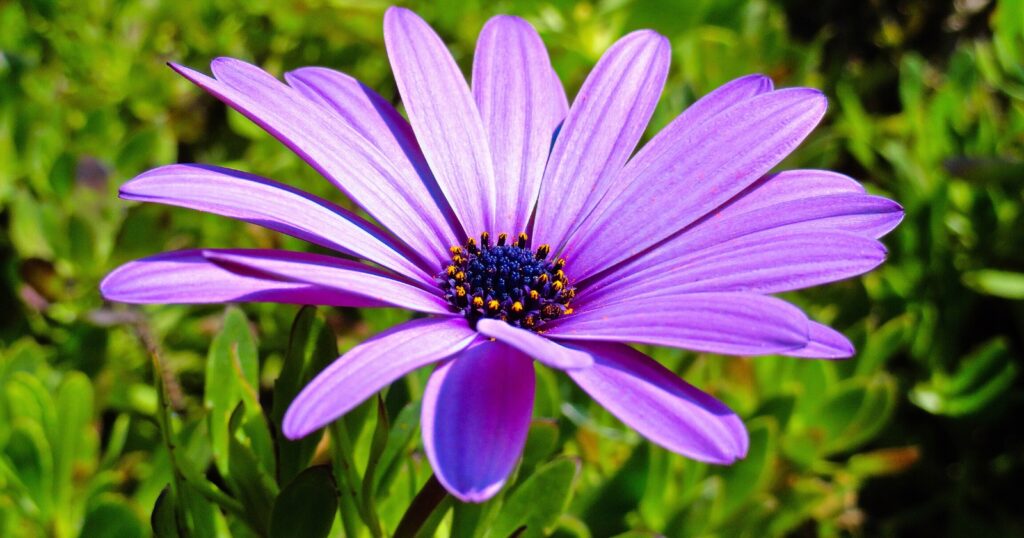
Scientific Name: Osteospermum
- Plant Type: Tender perennial
- Sun Exposure: Full sun
- Height When Mature: Up to 2 feet
- Soil pH: Alkaline, Neutral
- Plant Zone: 10 – 11
African Daisys, also known as Mums, are staples in most gardens and come in various bright summery colors. In cooler climates, these long bloomers flower from spring until the first frost. They are tender perennials, but they are usually grown as an annual outside their hardiness zones.
The African Daisy flowers measure up to 2 inches across and are very showy. Butterflies and other pollinators love them. They are low-maintenance flowers that like evenly moist, well-drained soils. Look out for varieties such as Soprano Purple, 4D Pink, and Zion Copper Amethyst to provide your landscape with bold purple hues.
Allioni’s Primrose
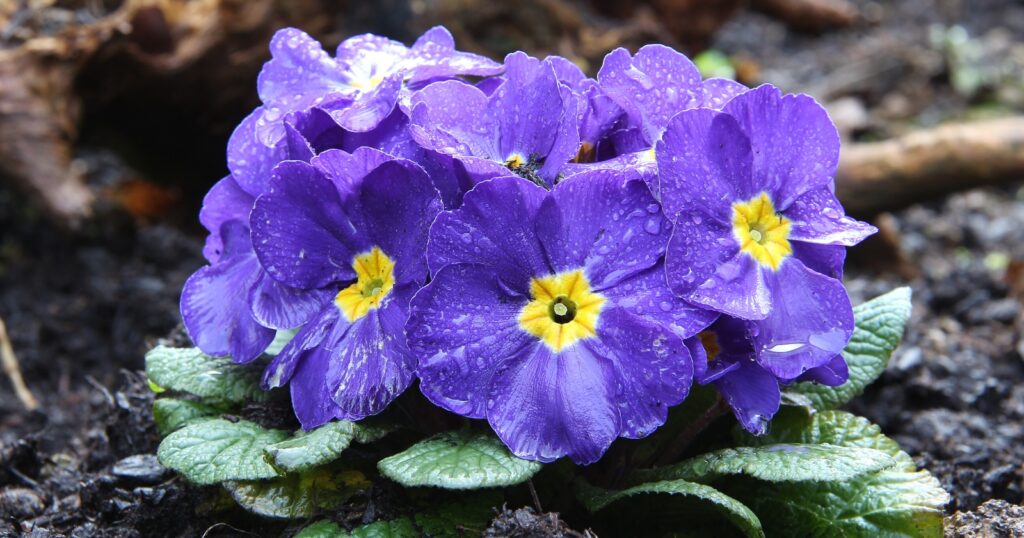
Scientific Name: Primula allionii
- Plant Type: Perennial
- Sun Exposure: Full sun, partial sun
- Height When Mature: Up to 4 inches
- Soil pH: Alkaline
- Plant Zone: 4 – 8
Allioni’s Primrose is one of the earliest blooming spring flowers from late winter to mid-spring. Providing your landscape with a pop of purple color before anything else appears. The rich lavender, heart-shaped petals are large compared to the plant, hiding the sticky evergreen foliage.
Allioni’s Primrose is native to the Alp regions of France, Italy, and other limestone cliff areas. They do really well in rock gardens, borders, and containers. This purple perennial is low maintenance, coming back year after year as long as you protect them from winter moisture. They are deer and rabbit-resistant but watch out for aphids and slugs.
Allium
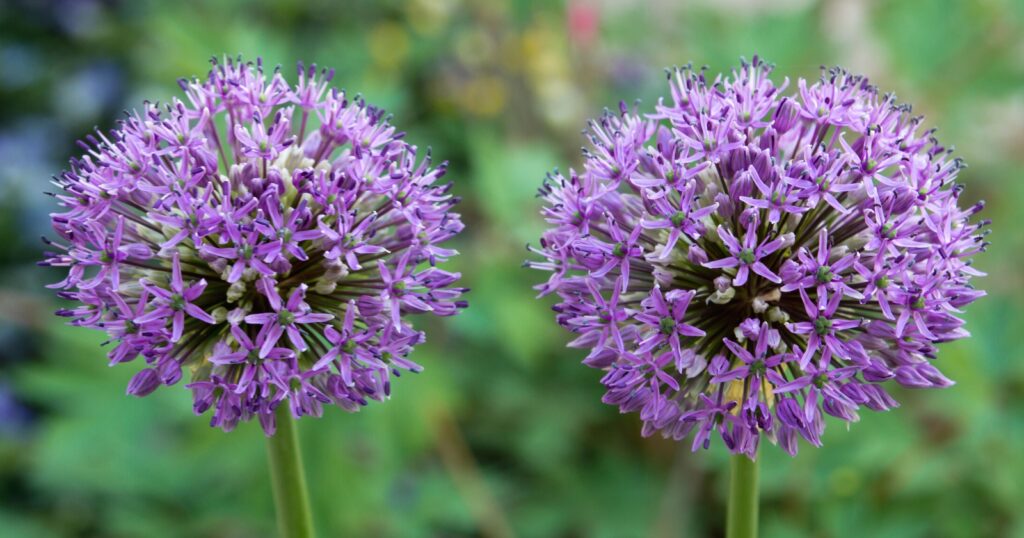
Scientific Name: Allium
- Plant Type: Perennial
- Sun Exposure: Full sun
- Height When Mature: Up to 4 feet
- Soil pH: Acid, Alkaline, Neutral
- Plant Zone: 4 – 9
Alliums are commonly known as Ornamental Onions, and it’s easy to see why. The tall, slender stems carry globes packed with hundreds of rich purple small star-shaped flowers. They typically bloom for around 5 weeks from late spring, and butterflies, bees, and other pollinating wildlife love them.
There are many Allium varieties, most purple, but they also come in white and pink. Alliums naturalize well and come back year after year. They prefer rich and gritty, well-drained soil that is dry to medium moisture. Plant them in groups of at least 10 for the best visual impact. Globemaster and Purple Sensation are prized varieties.
Anise Hyssop
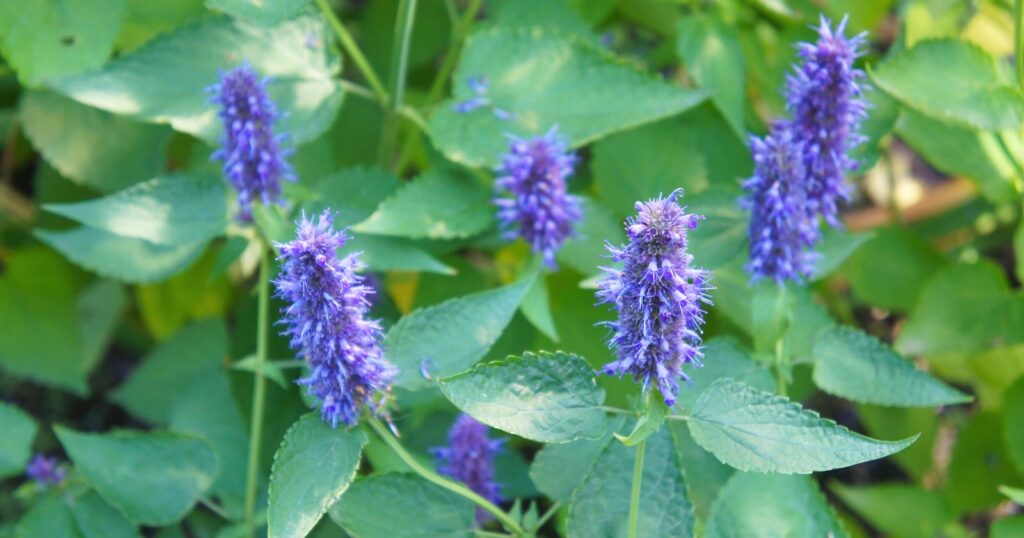
Scientific Name: Agastache foeniculum
- Plant Type: Perennial
- Sun Exposure: Full sun, partial sun
- Height When Mature: Up to 4 feet
- Soil pH: Acid, Alkaline, Neutral
- Plant Zone: 4 – 8
This is another tall perennial that provides purple plant lines for your landscape. Each stem is topped with tubes of tiny purple flowers from early summer to early fall. When brushed, the leaves release an anise scent, so be sure to plant it somewhere you can enjoy its fragrance.
Anise Hyssop is popular with gardeners because it returns yearly and tolerates all soils where other plants fail. It is low maintenance and resistant to virtually everything gardeners worry about. It is drought tolerant once established and self-seeds when happy. They are native to northern North America and make great cut flowers too.
Bee Balm
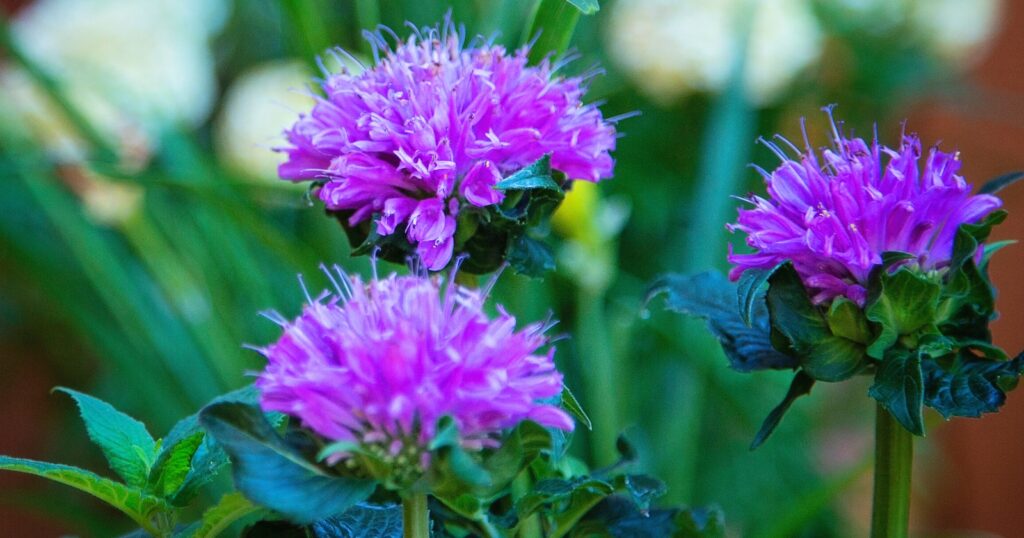
Scientific Name: Monarda
- Plant Type: Perennial
- Sun Exposure: Full sun, partial sun
- Height When Mature: Up to 4 feet
- Soil pH: Acid, Alkaline, Neutral
- Plant Zone: 4 – 9
Bee Balm is a clump-forming hardy perennial that comes in heights ranging from 1 to 4 feet tall, and they have different bloom times. There are also a variety of bright purples and striking patterns to choose from. Varieties such as Grape Gumball and Pardon My Lavender offer particularly bold purples.
Whichever Bee Balm you choose, each one is fragrant and releases a minty scent when brushed. So be sure to plant them where you can enjoy the fragrance. Bees, butterflies, and hummingbirds flock to Bee Balm. They need rich, moist, and well-drained soils to perform best. Bee Balm can be fast-growing and might need dividing every 3 years.
Blue Morning Glory
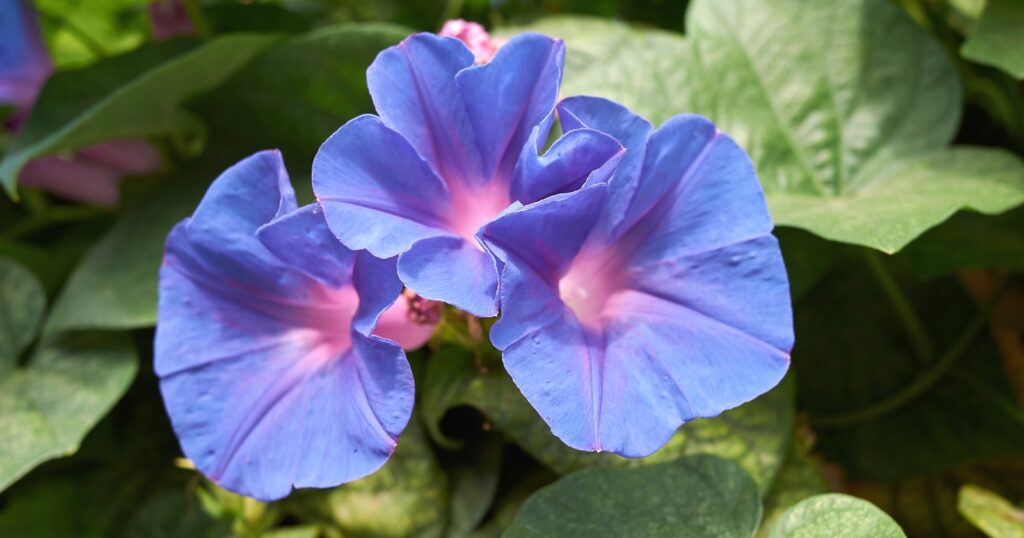
Scientific Name: Ipomoea indica
- Plant Type: Climbing perennial
- Sun Exposure: Full sun
- Height When Mature: Up to 15 feet
- Soil pH: Acid, Alkaline, Neutral
- Plant Zone: 9 – 11
Blue Morning Glory is a fast-growing evergreen vine that is found in tropical habitats across the world. It needs support such as a fence or a trellis and can grow up to 15 feet tall in one season. This perennial is excellent if you want to quickly cover an unsightly fence or wall. Place it in the full sun and in loamy, well-drained soils.
It produces trumpet-shaped violet flowers from spring to the first frost. The flowers open bright blue in the morning, gradually fading to pinkish-purple by the afternoon before closing at night. This flower attracts butterflies and hummingbirds but is toxic to dogs, cats, and horses.
Butterfly Bush
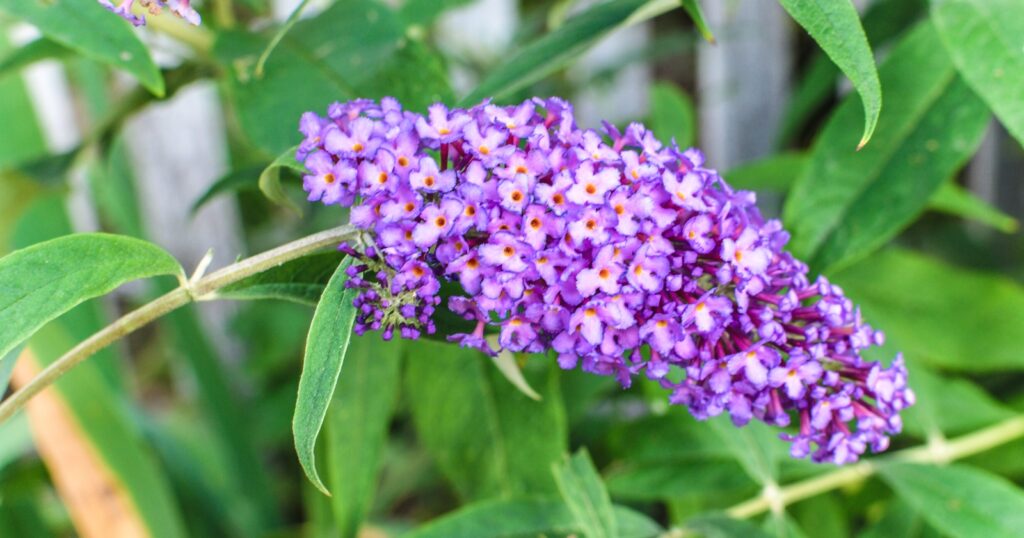
Scientific Name: Buddleja davidii
- Plant Type: Perennial
- Sun Exposure: Full sun
- Height When Mature: Up to 8 feet
- Soil pH: Acid, Alkaline, Neutral
- Plant Zone: 5 – 9
Butterfly Bush is a perennial semi-evergreen shrub that can grow up to 8 feet tall, making it ideal for the back of your borders. The flower spikes bloom from summer to fall, producing hundreds of tiny, purple, sweetly fragrant flowers. The variety, Buzz Midnight, is exceptionally bold purple with bright orange throats.
Buddleja davidii is native to China but is listed as an invasive plant in some parts of the US. Butterfly Bush needs well-drained soil with medium moisture but cannot tolerate very wet conditions. Butterfly Bush attracts a broad butterfly audience, making it a must in wildlife gardens.
Candle Larkspur
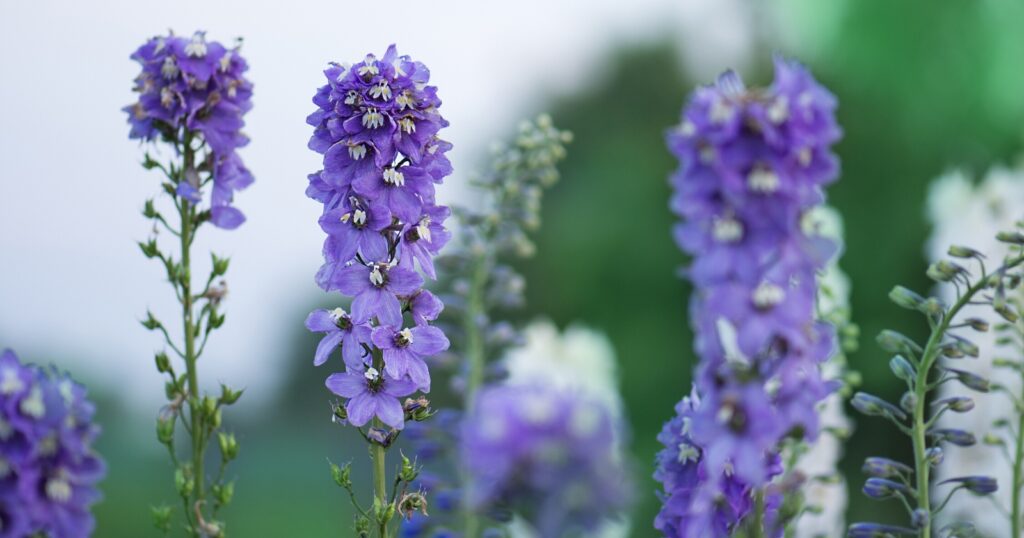
Scientific Name: Delphinium elatum
- Plant Type: Perennial
- Sun Exposure: Full sun, partial sun
- Height When Mature: Up to 7 feet
- Soil pH: Acid, Alkaline, Neutral
- Plant Zone: 3 – 7
Candle Larkspur are tall, herbaceous perennials that grow high toward the sky. Large flower spikes are tightly packed with rich violet flowers. They bloom in early summer and again a few weeks later. Candle Larkspur is a solid choice if you’re looking for bold purple lines in your landscape.
They are native to woodlands and river valleys in central to southern Europe. They need medium moisture, well-drained soils with some shelter to protect them against winds. Candle Larkspur are generally low-maintenance plants that look best when planted in groups. They make excellent cut flowers too.
Catmint
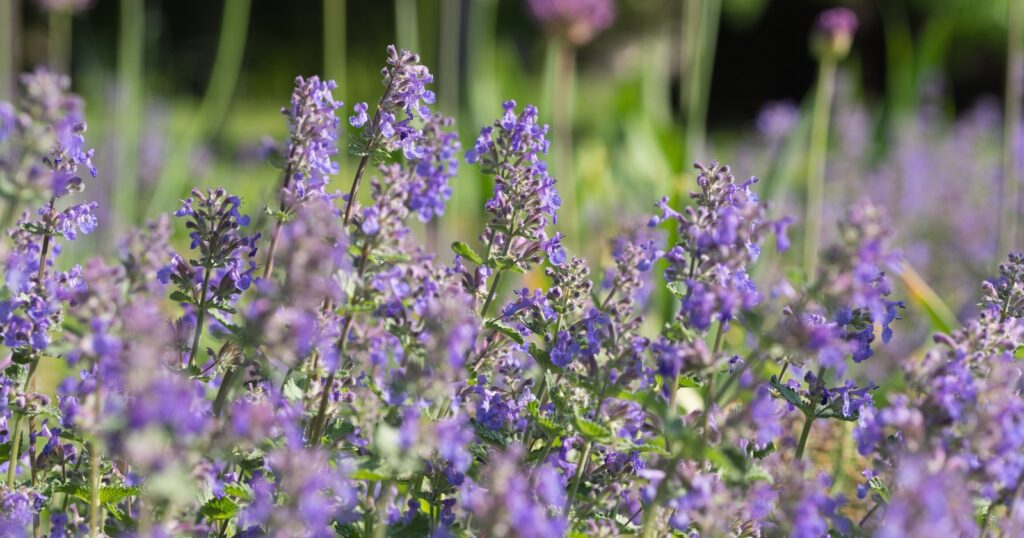
Scientific Name: Nepeta racemosa
- Plant Type: Perennial
- Sun Exposure: Full sun, partial sun
- Height When Mature: Up to 3 feet
- Soil pH: Acid, Alkaline, Neutral
- Plant Zone: 3 – 8
Catmint is a popular perennial with gardeners for its showy and profuse blooms. Mounted on short spikes, they bloom throughout summer and into the fall. They are low-maintenance, return reliably, and are exceptionally hardy. All they ask for is dry to medium moisture, well-drained soils. Other than this, they are tolerant of most soils.
The gray-green foliage is aromatic and pretty, making the bold purple blooms pop in all landscapes. Plant them anywhere in the garden, along pathways, or in rock gardens. They also look great in containers. Catmint is salt and humidity tolerant, too, making them a top choice for coastal areas.
Clematis
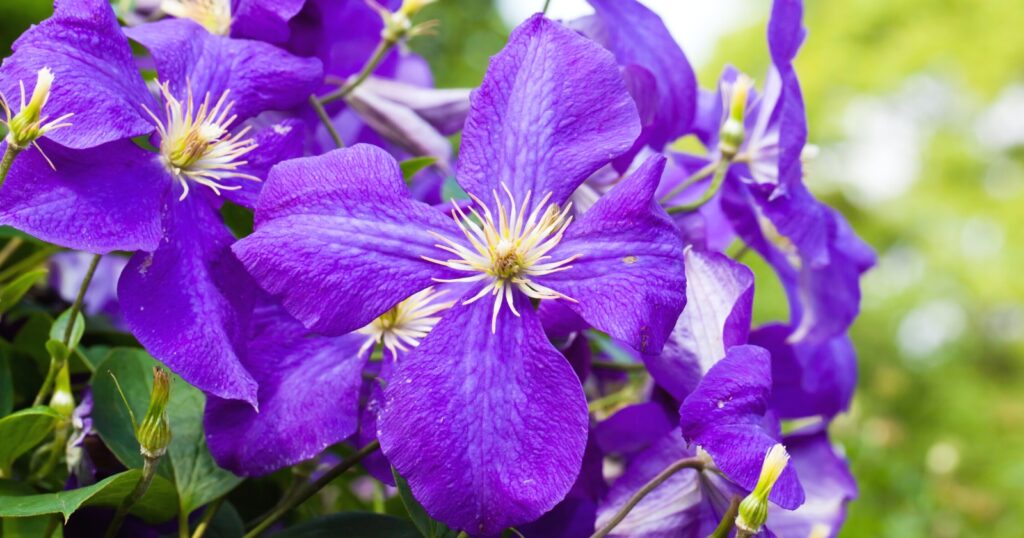
Scientific Name: Clematis
- Plant Type: Climbing perennial
- Sun Exposure: Full sun, partial sun
- Height When Mature: Up to 10 feet
- Soil pH: Alkaline, Neutral
- Plant Zone: 4 – 11
There are 12 groups of Clematis comprising 300 species, all with different bloom times, sizes, and colors. So it’s important to research which one you want for your landscape. There are a variety of bold purple flowers to pick from. Exceptionally bright purple species include Anna Louise, Etoile Violette, Fireworks, and Sweet Summer Love.
Clematis are climbing perennials that are great options for the back of beds and against fences and trellises. Be sure to provide it with something to climb; otherwise, it will climb whatever it wants. They produce large, star-shaped blooms from spring until fall and need moist, well-drained soils. Clematis prefer their heads in the sun and feet in the shade.
Colorado Four O’Clock
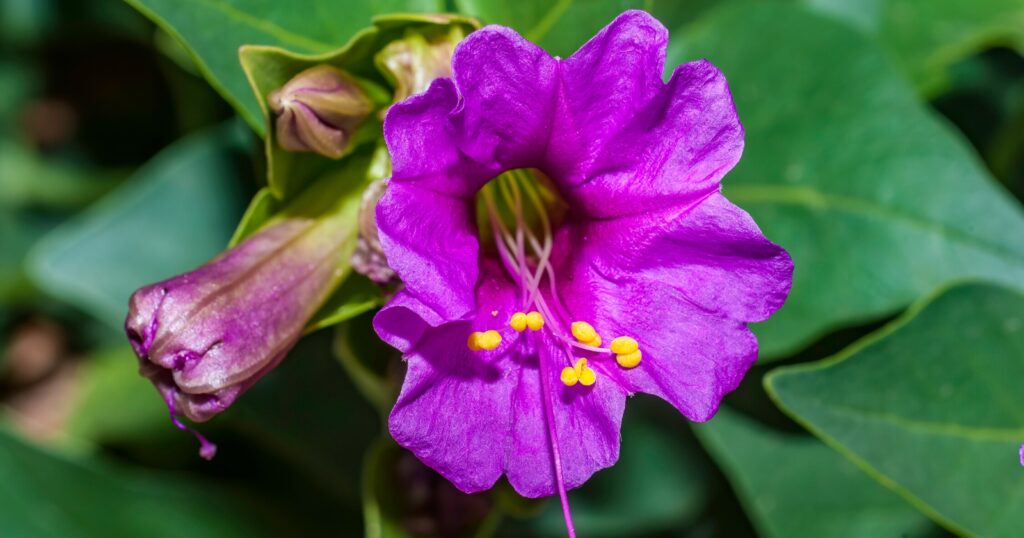
Scientific Name: Mirabilis multiflora
- Plant Type: Perennial
- Sun Exposure: Full sun
- Height When Mature: Up to 2 feet
- Soil pH: Acid, Alkaline, Neutral
- Plant Zone: 4 – 8
This long-season easy-going bloomer is a hardy perennial that produces masses of highly fragrant blooms. Making it a top choice for most gardeners. The flowers are bright pinkish-purple with delicate yellow-tipped stamen. The blossoms open in the afternoon and close in the morning, attracting night insects and pollinators. Plant it close to where you can enjoy the scent at nighttime.
Colorado Four O’Clock has a sprawling habit making it a top choice for gardeners looking for ground cover or as a trailing plant over garden walls. It is also an excellent erosion control plant thanks to its extensive root system. It needs dry and well-drained soils to do well.
Cranesbill

Scientific Name: Geranium
- Plant Type: Perennial
- Sun Exposure: Full sun, partial sun
- Height When Mature: Up to 3 feet
- Soil pH: Acid, Alkaline, Neutral
- Plant Zone: 3 – 9
You are spoilt for choice when it comes to gorgeous Geraniums. They are hardy perennials that are easy to grow, pest and disease-resistant, and require little care. In return, they provide masses of bold blooms from spring through to fall. All they ask for is moderately fertile, well-drained soil.
They come back in the right conditions year after year, even better than the previous year. They look great in borders and containers or hanging baskets where you can honor their trailing habit. Award-winning purple Cranesbill to consider includes Patricia, Rozanne, and Sweet Heidi.
Creeping Phlox
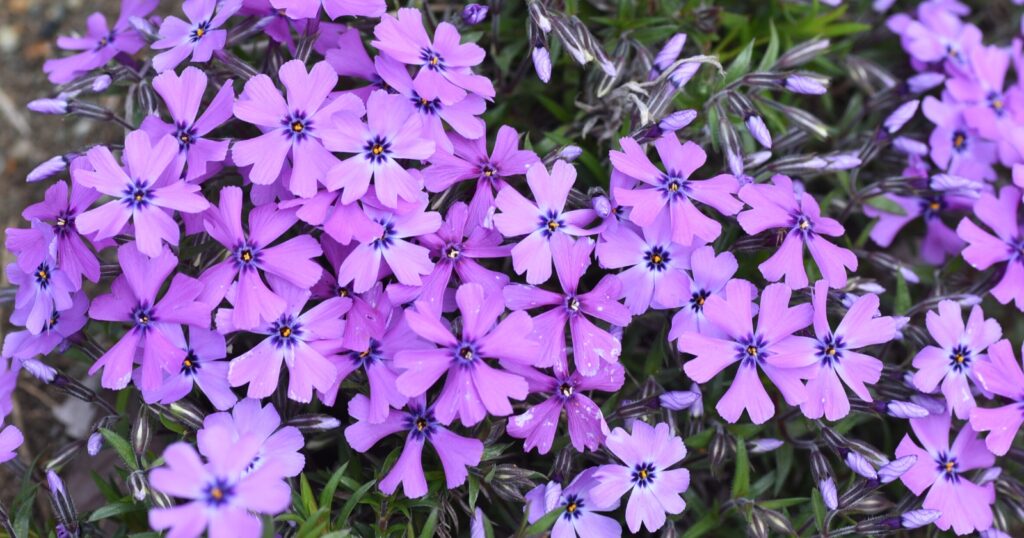
Scientific Name: Phlox subulata
- Plant Type: Perennial
- Sun Exposure: Full sun
- Height When Mature: Up to 6 inches
- Soil pH: Alkaline, Neutral
- Plant Zone: 3 – 9
Creeping Phlox is a beautiful choice for gardeners looking for a bold purple carpet in the early spring. The rosemary-like foliage is evergreen, but when in bloom, you cannot see it for the purple star-shaped flowers. It is native to the eastern and central USA and prefers sandy, rocky, dry habitats.
Creeping Phlox spreads quickly in the right conditions, creeping wherever there is room. They are also ideal for adding color to a retaining wall as they trail gracefully. To promote blooms next year, shear back the evergreen foliage after flowering. Butterflies love this plant.
Dahlia
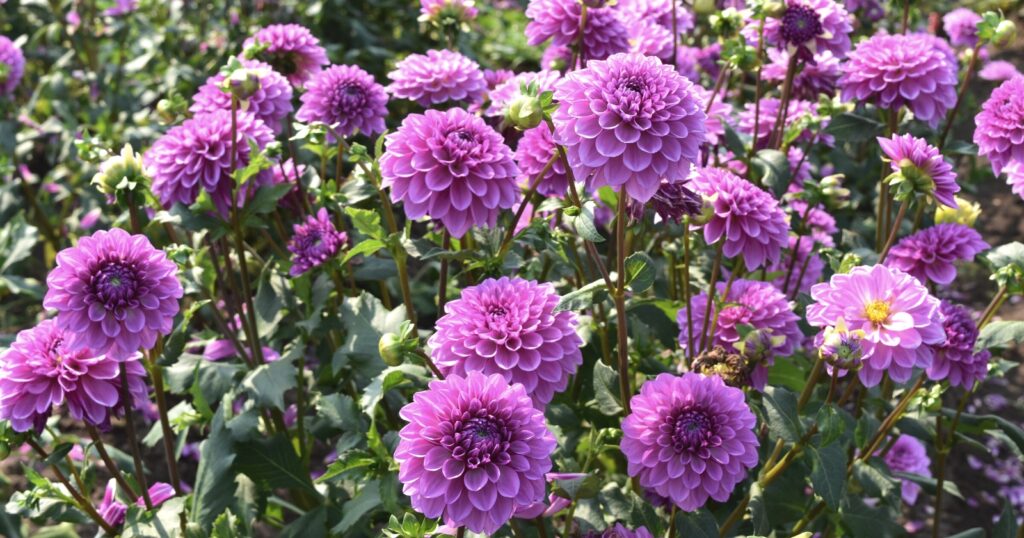
Scientific Name: Dahlia
- Plant Type: Tender perennial
- Sun Exposure: Full sun
- Height When Mature: Up to 6 feet
- Soil pH: Acid, Alkaline, Neutral
- Plant Zone: 8 – 11
Dahlias are bulbous perennials, although, in cooler climates, they are sometimes considered annuals. If you want to save your Dahlia bulbs for next year, they must be dug up before the first frost and replanted in the spring. But when you see the showstopping blooms, you’ll agree it’s worth the extra maintenance.
Dahlias come in a wide variety of bright colors, including bold purple hues. Exceptional violet varieties include Diva, Jowey Mirella, and Marble Ball. Flowering from summer until the fall, they need full sun and consistent but well-drained moisture.
Daylily
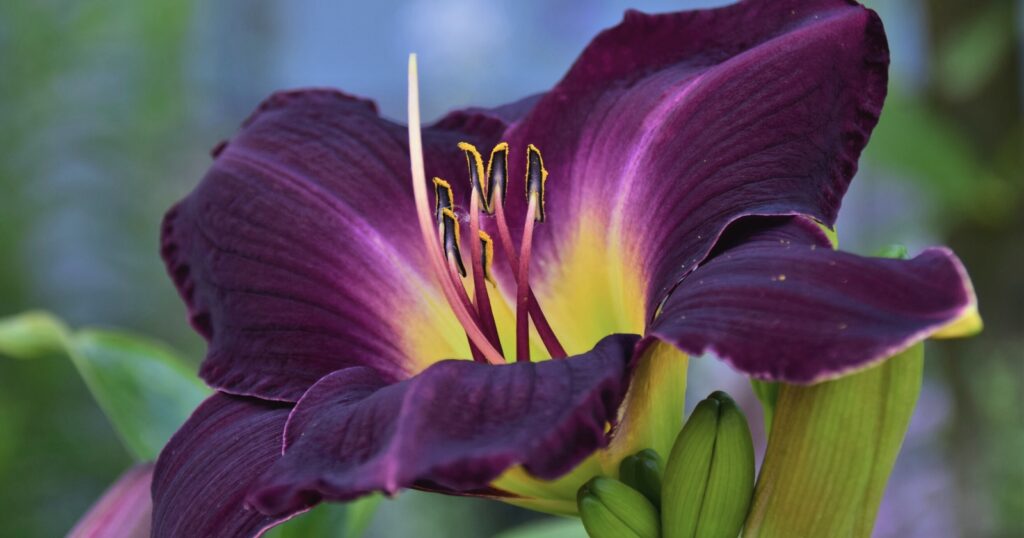
Scientific Name: Hemerocallis
- Plant Type: Perennial
- Sun Exposure: Full sun, partial sun
- Height When Mature: Up to 4 feet
- Soil pH: Acid, Alkaline, Neutral
- Plant Zone: 3 – 9
Daylilies are eye-catching flowers that bloom for several weeks in the summer season. They produce large, trumpet-shaped flowers that sit atop tall, erect stems. They only last for 24 hours on average. But they are quickly replaced, providing an endless punch of purple for your perennial border.
Daylilies are referred to as the perfect perennial because they are easy to care for, simple to grow, hardy, and super showy. It prefers moist, well-drained soils but can tolerate many environments. Daylilies are toxic to cats. Little Grapette, Nosferatu, and Purple Passage are fantastic purple options to consider.
English Lavender
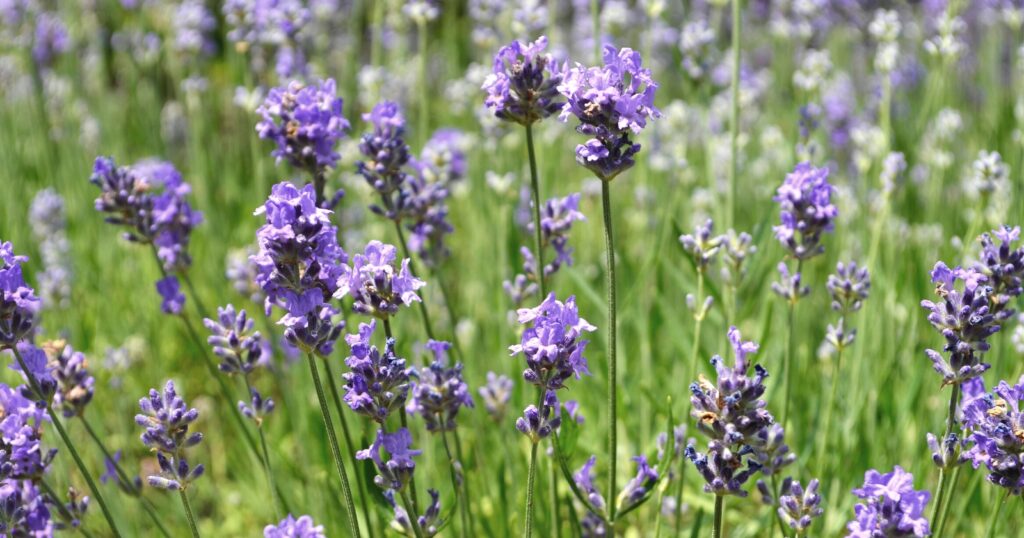
Scientific Name: Lavandula angustifolia
- Plant Type: Perennial
- Sun Exposure: Full sun
- Height When Mature: Up to 3 feet
- Soil pH: Acid, Alkaline, Neutral
- Plant Zone: 5 – 8
English Lavender is an eye-catching and sweetly scented perennial option that is popular worldwide. It grows quickly, tolerates wet winters, and produces long-lasting, elegant blooms. Sometimes reblooming later in the season in its preferred conditions. In warmer climates, it is evergreen providing an excellent backdrop for other plants.
The stems carry flower spikes adorned with intense lavender color that bees and butterflies cannot resist. They make excellent cut flowers, fresh or dried. Lavender looks great when planted in a large group or used as a hedge or backdrop. It likes dry to medium soil that is sandy and well-drained.
False Indigo
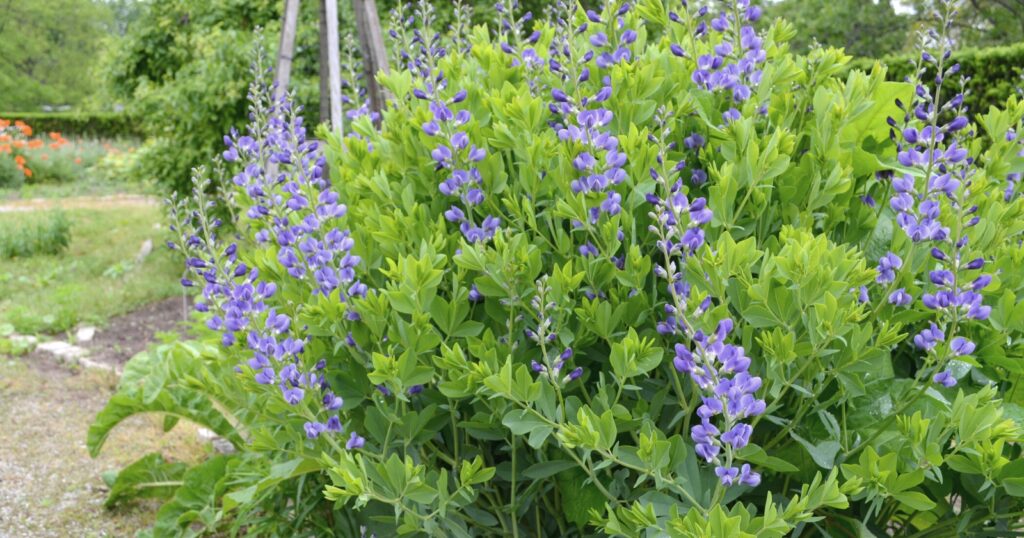
Scientific Name: Baptisia
- Plant Type: Perennial
- Sun Exposure: Full sun
- Height When Mature: Up to 5 feet
- Soil pH: Acid, Neutral
- Plant Zone: 4 – 9
Baptisia is very floriferous and carries spikes of pea-shaped violet-blue flowers. They bloom from late spring for several weeks. After flowering, they produce black seedpods taking their interest into the winter. The bright foliage provides a brilliant backdrop for other perennials for the rest of summer.
False Indigo likes dry to medium moisture and well-drained average soils. It is relatively hardy, but don’t move it once established, as the root system is easily damaged. It attracts hummingbirds and butterflies but is rabbit and deer resistant.
Field Gladiolus
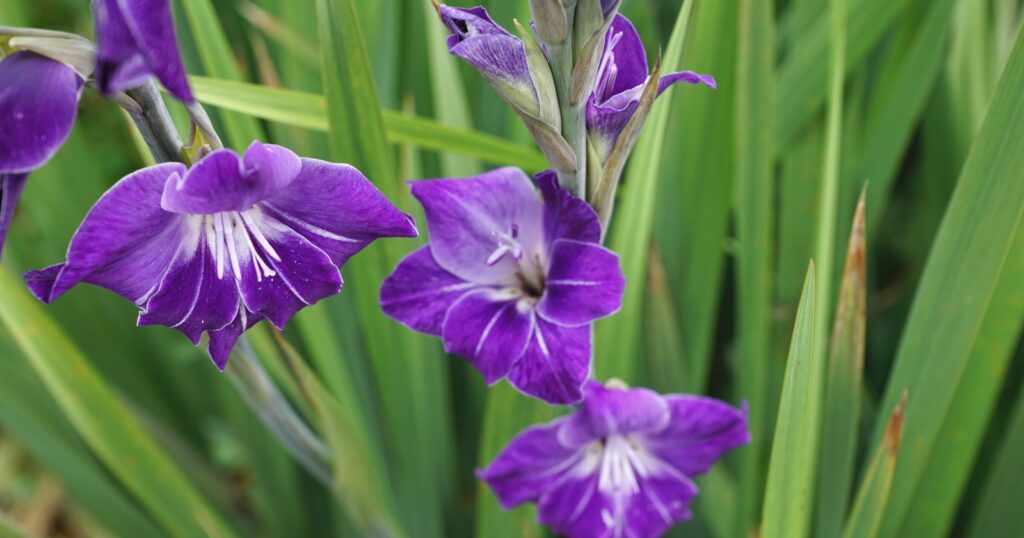
Scientific Name: Gladiolus italicus
- Plant Type: Perennial
- Sun Exposure: Full sun
- Height When Mature: Up to 3 feet
- Soil pH: Acid, Alkaline, Neutral
- Plant Zone: 8 – 10
This cormous perennial produces spikes of 20 pinkish-purple flowers that sit above sword-like foliage in late spring to early summer. The bottom petals are lighter in color, providing a multi-colored appearance. Field Gladiolus look great when planted in large groups and come into their own when swaying in the wind.
Field Gladiolus is native to Southern Europe and prefers full sun. They need fertile, well-drained soils that are moderately moist. After flowering, they prefer dry conditions and need thick mulch to survive winters.
Fumewort
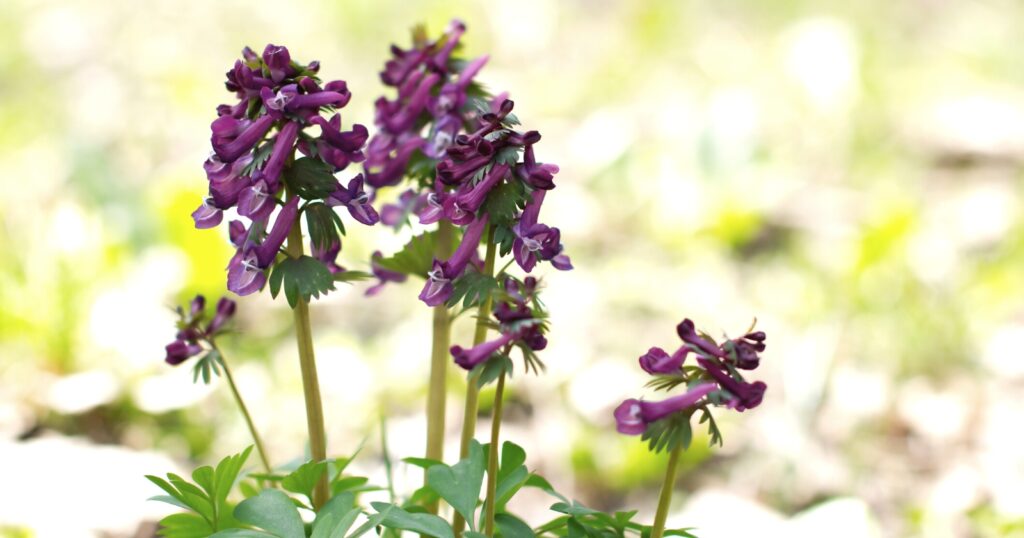
Scientific Name: Corydalis
- Plant Type: Perennial
- Sun Exposure: Partial sun, shade
- Height When Mature: Up to 1 foot
- Soil pH: Acid, Alkaline, Neutral
- Plant Zone: 5 – 9
Here we have a low-growing perennial that only reaches up to 1 foot tall. The foliage is lacy and blue-green, which gives way to stems in early fall. From these stems come racemes of trumpet-shaped purple flowers that are striking and highly fragrant. Be sure to plant them somewhere you can appreciate their beauty and sweet scent.
Fumewort loves a shady spot in a garden or on wet banks or slopes. It does particularly well in woodlands and rock gardens as long as the soil is evenly moist and well-drained. It tolerates humidity and heat but not summer drought.
Grass Pink
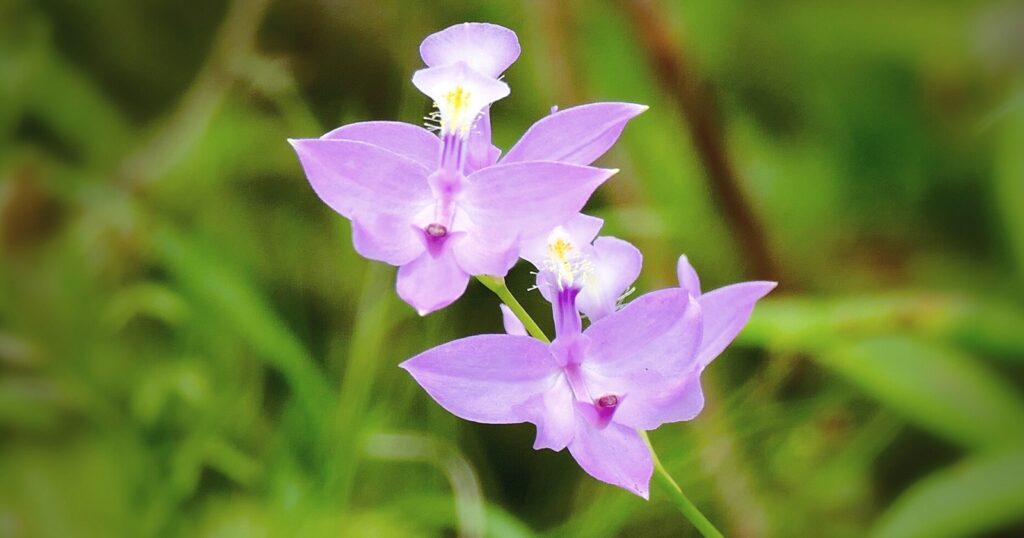
Scientific Name: Calopogon tuberosus
- Plant Type: Perennial
- Sun Exposure: Full sun
- Height When Mature: Up to 4 feet
- Soil pH: Acid, Neutral
- Plant Zone: 4 – 10
This is an excellent option if you’re looking for a perennial purple Orchid to add to your landscape. The arching, willowy stems carry several flowers that last for several weeks in spring and summer. They have a gold and white beard at the tip, contrasting with the rich lilac color.
Once Grass Pink stops blooming, seed pods carrying thousands of tiny seeds allow the beautiful plant to multiply, forming colonies. They are native to eastern North America and prefer a wet and sunny spot to thrive. Making them a top choice as a perennial pondside partner.
Great Masterwort
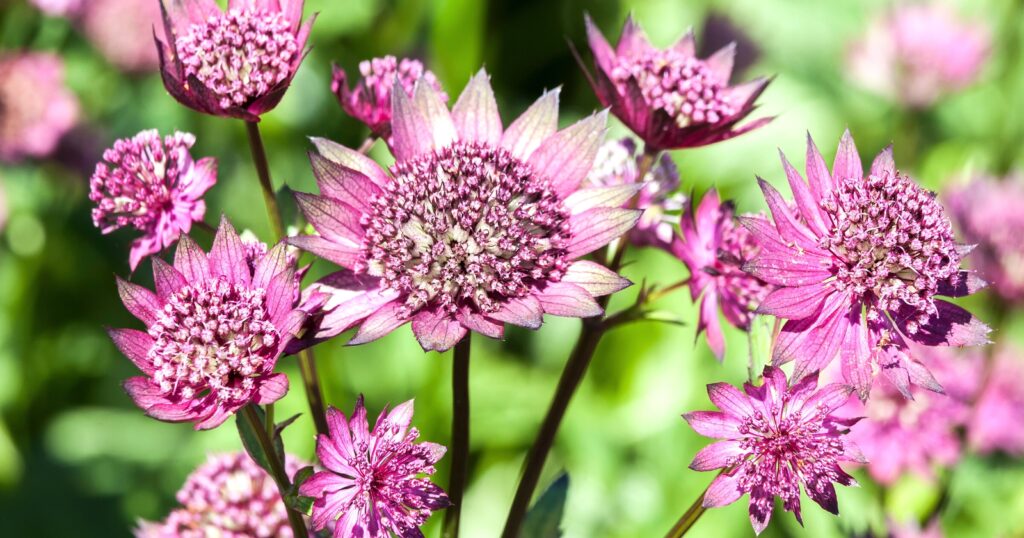
Scientific Name: Astrantia major
- Plant Type: Perennial
- Sun Exposure: Full sun, partial sun
- Height When Mature: Up to 3 feet
- Soil pH: Acid, Alkaline, Neutral
- Plant Zone: 4 – 7
Rosettes of darkly-colored, toothed leaves give way to purple stems carrying dome-shaped flower heads. Looking like pins on a cushion, clusters of rich magenta-purple flowers come together to provide a deep hue. It blooms for several weeks from spring to summer. When it is happy, it reblooms later in the summer.
Great Masterwort likes consistently moist but well-drained soils to thrive in full to partial sun. They look great in any landscape and mix well with various flowers. It is pest and disease tolerant and requires little effort to care for. Astrantias are excellent for cutting and dried bouquets too.
Greater Knapweed
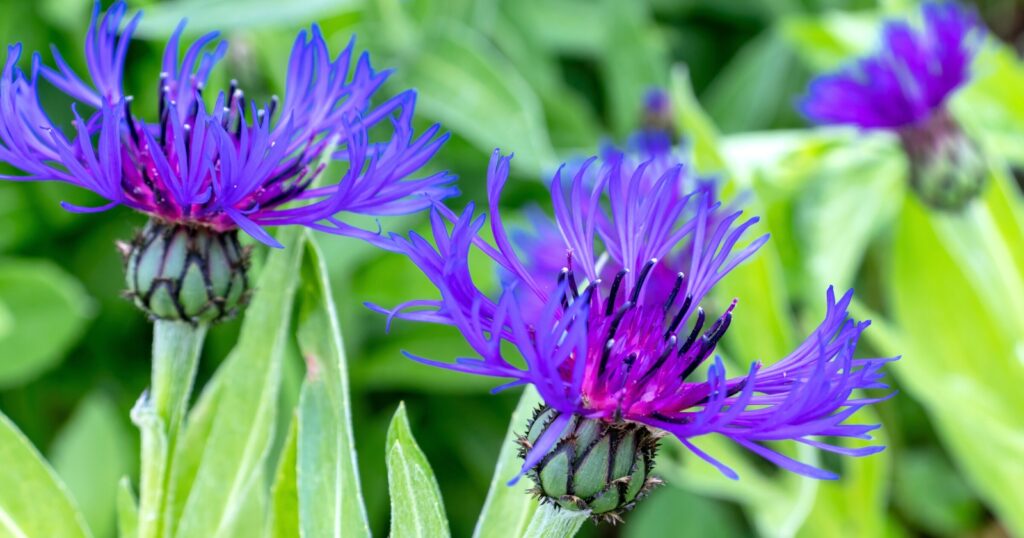
Scientific Name: Centaurea scabiosa
- Plant Type: Perennial
- Sun Exposure: Full sun
- Height When Mature: Up to 3 feet
- Soil pH: Acid, Alkaline, Neutral
- Plant Zone: 4 – 8
Greater Knapweed is an upright perennial that produces thistle-like rich purple blooms. Sturdy stems carry a 2-inch wide flower with outer florets, providing a spectacular show against the deep green foliage. It attracts a wide range of pollinators and is an excellent choice for wildlife lovers.
Greater Knapweed likes dry, well-drained soils and full sun. This plant is native to Great Britain but is a self-seeding invasive species in some parts of the US. For this reason, you must keep it in check if you don’t want it to take over. Deadheading helps to prevent self-seeding and prolongs the bloom season.
Hydrangea
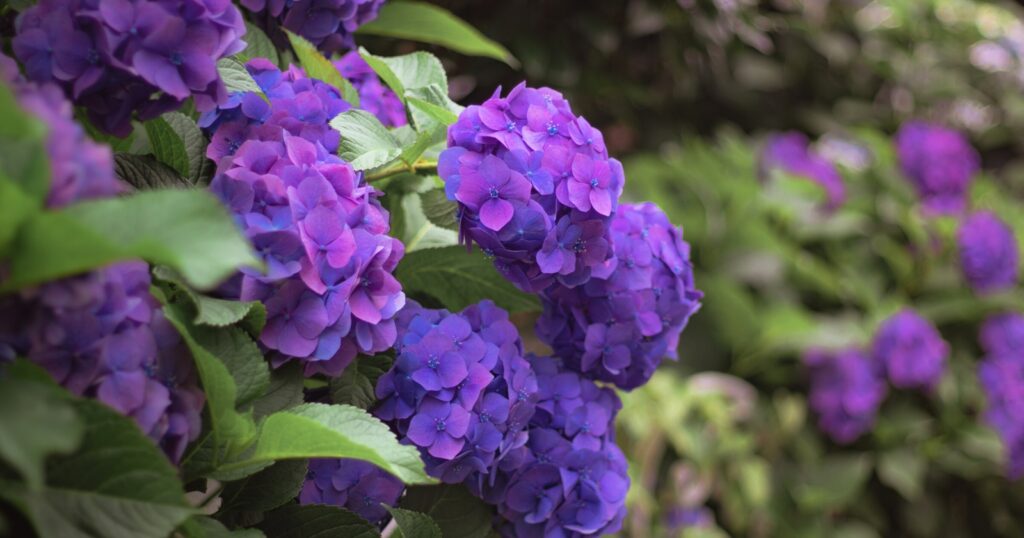
Scientific Name: Hydrangea macrophylla
- Plant Type: Perennial
- Sun Exposure: Full sun, partial sun
- Height When Mature: Up to 5 feet
- Soil pH: Acid, Alkaline, Neutral
- Plant Zone: 5 – 9
The Hydrangea is a popular perennial shrub across the world for its huge clusters of deep pink to blue flowers. Gardeners can influence the color of the bloom by adjusting the soil pH. Add aluminum sulfate if you want rich violet-blue hues or lime to make them pinker. In the fall, the clusters turn a lovely shade of plum and are great for dried bouquets.
Hydrangeas like rich, medium moisture soils that are well-drained. It is hardy and can tolerate full sun if kept evenly moist. Hydrangeas are versatile and look great spontaneously planted in the bed or containers as an accent plant.
Italian Aster
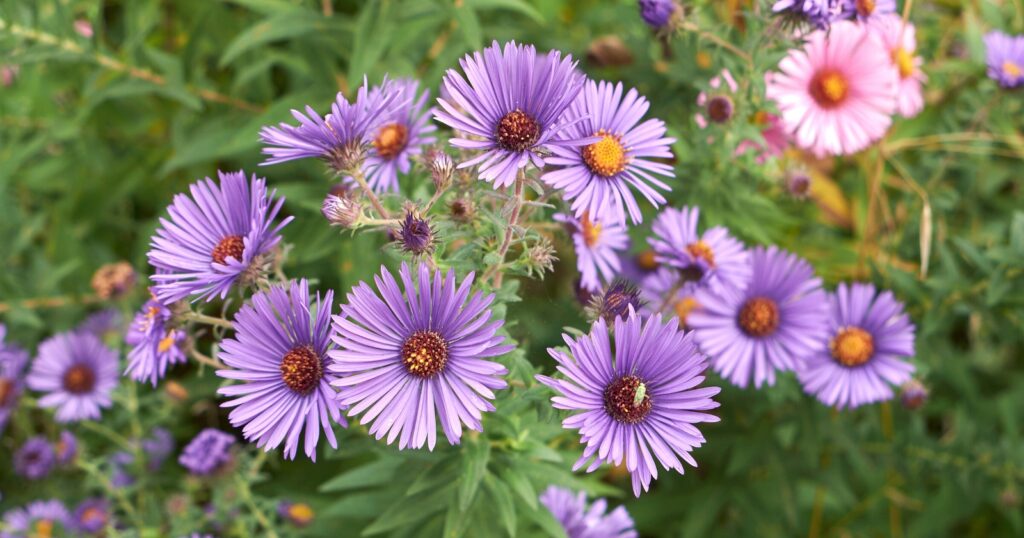
Scientific Name: Aster amellus
- Plant Type: Perennial
- Sun Exposure: Full sun
- Height When Mature: Up to 3 feet
- Soil pH: Alkaline, Neutral
- Plant Zone: 5 – 8
Italian Asters are very showy thanks to their large, daisy-like blooms measuring 3 inches wide. The long, thin lavender-blue petals encase a bright yellow disc that attracts a wide array of butterflies, bees, and birds. It is a late bloomer, providing a splash of rich purple hues in the fall season.
This Aster provides large blooms compared to its neat and compact shape, which is ideal for traditional or minimalistic gardens. Italian Asters like full sun and well-drained, medium moisture soils. It can tolerate drought, but be sure to provide it with space as it needs good air circulation.
Lenten Rose
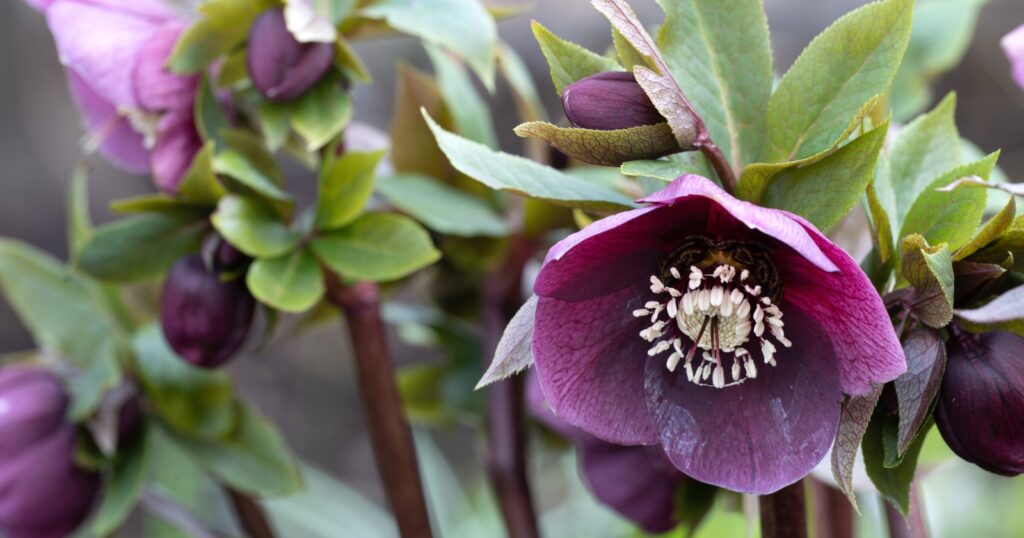
Scientific Name: Helleborus
- Plant Type: Perennial
- Sun Exposure: Partial sun, shade
- Height When Mature: Up to 2 feet
- Soil pH: Alkaline, Neutral
- Plant Zone: 4 – 9
Lenten Roses are shade lovers, making them ideal for gardens that struggle with sun-seeking plants. Plant them under trees or shrubs where other flowers would fail. Varieties such as Blushing Bridesmaid and Shotgun Wedding provide deep purple hues with contrasting white for a pop of color.
Lenton Roses bloom for a few weeks in early spring, around lent, hence its name. It grows in an evergreen, upright clump for year-round interest. They like humus-rich, averagely moist soils that are well-drained. Helleborus is a vital nectar source, but deer and rabbits tend to ignore it.
Lungwort
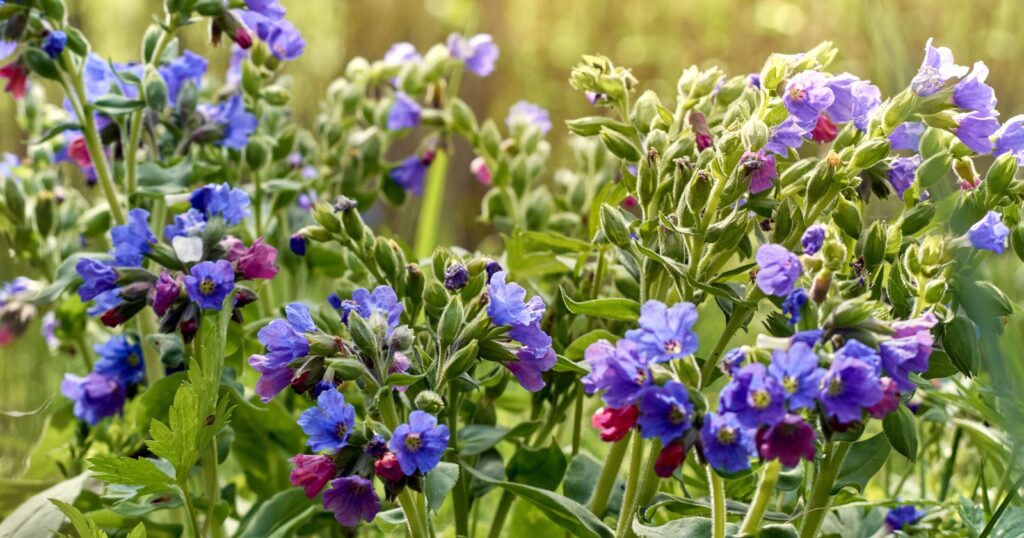
Scientific Name: Pulmonaria
- Plant Type: Perennial
- Sun Exposure: Partial sun, shade
- Height When Mature: Up to 1 foot
- Soil pH: Acid, Alkaline, Neutral
- Plant Zone: 3 – 9
Lungwort is another shade-seeking perennial boasting bright purple splashes of color. Raspberry Splash and Blue Ensign are considered two of the best Pulmonaria cultivars. Lungwort provides gardens with clusters of rich purple-pink flowers that bloom mid to late spring.
The foliage is just as beautiful, with its deep green leaves heavily spotted with silver. In mild winter areas, it remains evergreen. Lungwort is a low-maintenance flower, just be sure to cut them back after flowering. They require rich, moist, and well-drained soils to do well in a shady spot.
Meadow Rue
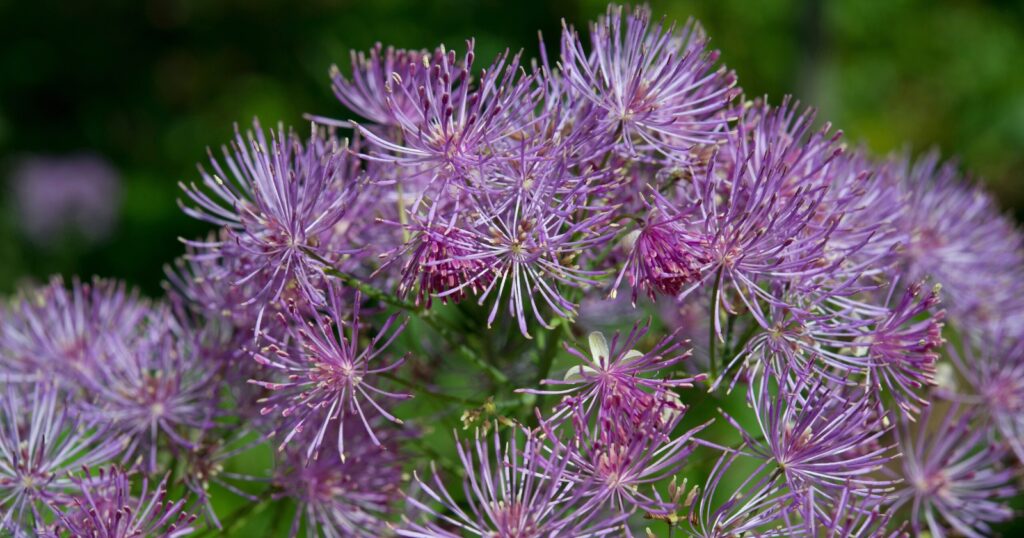
Scientific Name: Thalictrum aquilegiifolium
- Plant Type: Perennial
- Sun Exposure: Full sun, partial sun
- Height When Mature: Up to 3 feet
- Soil pH: Acid, Alkaline, Neutral
- Plant Zone: 5 – 8
Meadow Rue is prized for its lacy foliage and wonderful pannicles of firework-like flowers that bloom from late spring to early summer. The petals are rich lilac tipped with yellow, adding to their explosive look. After flowering, it gives way to wing-like seedpods.
It is a clump-forming plant that usually grows up to 3 feet tall and wide, making it a top choice for the backs of beds. Meadow Rue prefers medium moisture, well-drained soils in dappled shade, and it cannot tolerate humid or hot summer climates. It’s important not to let the moist soil become boggy.
Monkshood
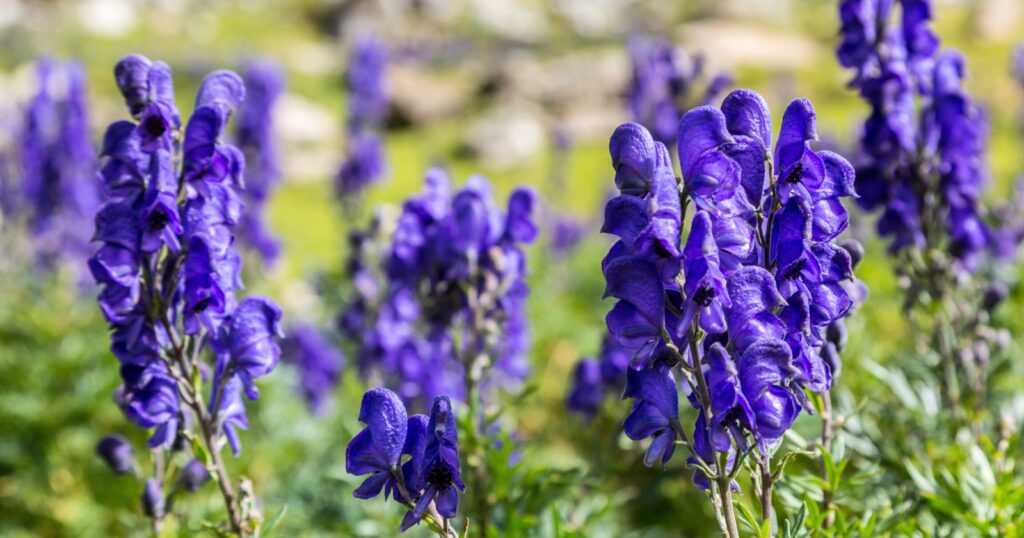
Scientific Name: Aconitum napellus
- Plant Type: Perennial
- Sun Exposure: Full sun, partial sun
- Height When Mature: Up to 4 feet
- Soil pH: Acid, Alkaline, Neutral
- Plant Zone: 3 – 8
Monkshood provides densely packed purple flower spikes from mid to late summer. If you cut the flowers back, you might encourage reblooming later in the season. The flowers resemble hoods worn by medieval monks, hence its name.
It needs rich and constantly moist, well-drained soils in full sun or partially sunny spots. The whole plant is toxic to animals and humans, so it is essential to plant it away from the reach of children and always wear gloves when working with it. Given its toxicity and its height, the back of a bed is an excellent location for it.
Pacific Anemone
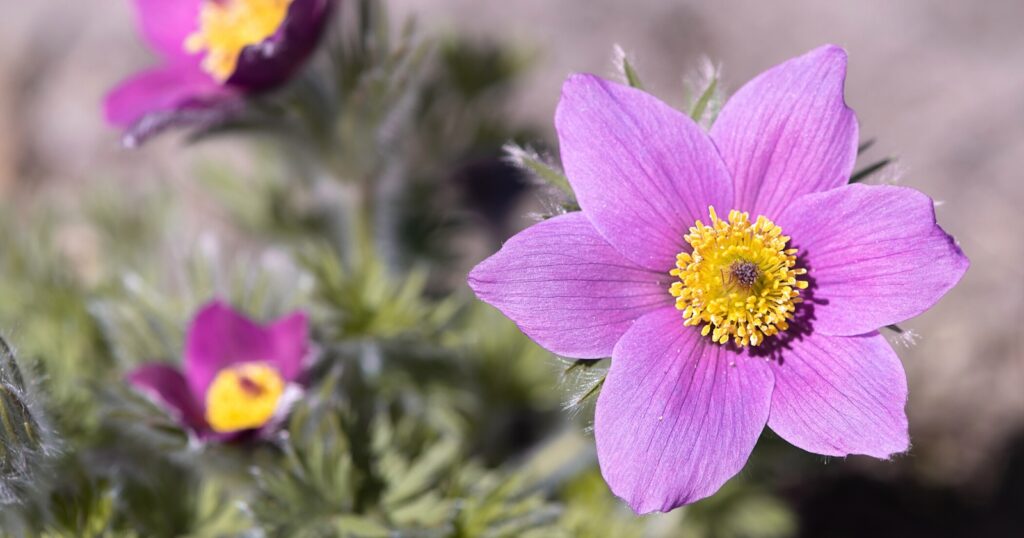
Scientific Name: Anemone multifida
- Plant Type: Perennial
- Sun Exposure: Partial sun
- Height When Mature: Up to 2 feet
- Soil pH: Acid, Alkaline, Neutral
- Plant Zone: 3 – 9
The Pacific Anemone grows in clumps of slender stalks covered in deep-green foliage. From late spring, silky rich-purple-pink poppy-like flowers are born and last for several weeks. After flowering, it produces pink seedpods that hummingbirds use to build their nests. Making it an essential addition to wildlife gardens.
It is a north American plant that prefers woodlands with dappled shade and moist but gravelly soils. The Pacific Anemone looks wonderful in beds, borders, rock gardens, containers, or anywhere with shade. It is hardy with no real risk of disease or pests.
Pasque Flower
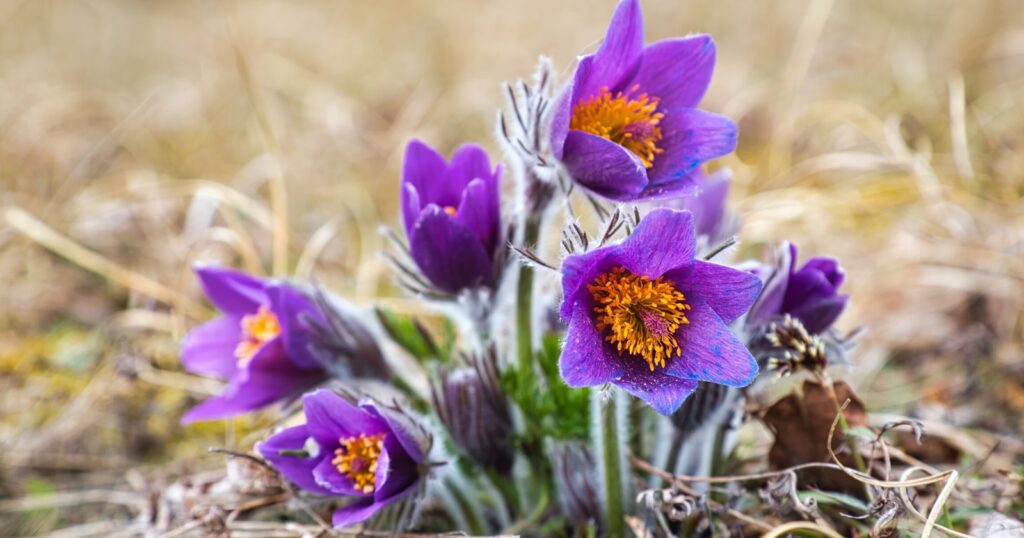
Scientific Name: Pulsatilla vulgaris
- Plant Type: Perennial
- Sun Exposure: Full sun
- Height When Mature: Up to 1 foot
- Soil pH: Acid, Alkaline, Neutral
- Plant Zone: 4 – 8
The Pasque Flower is one of the earliest blooming spring perennials. It produces bell-shaped blossoms that nod when they open and gradually look up toward the sun. The deep purple-blue petals contrast with the golden stamens and fuzzy stems. Each flower head measures up to 3 inches wide, and each plant can produce over 30 blossoms in one season. The ferny foliage is equally attractive, as are the ornamental seedheads that follow.
The Pasque Flower is native to Great Britain and Europe, and they like sunny but dry spots. The soil you plant it in must be well-drained by consistently moist to thrive. It looks great in rock gardens or the front of beds.
Passion Flower
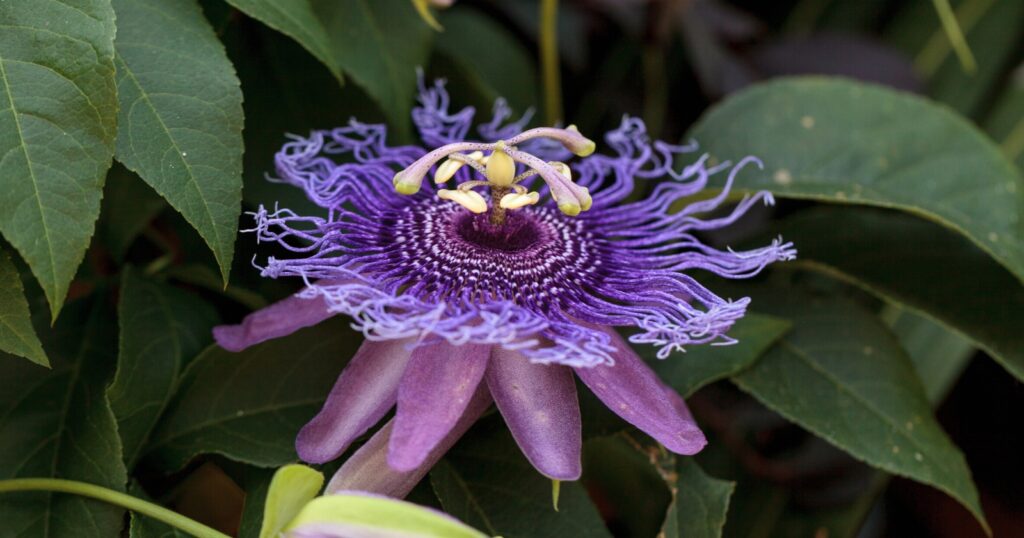
Scientific Name: Passiflora
- Plant Type: Climbing perennial
- Sun Exposure: Full sun, partial sun
- Height When Mature: Up to 30 feet
- Soil pH: Acid, Alkaline, Neutral
- Plant Zone: 6 – 11
The Passion Flower produces blooms with an out-of-this-world appearance. An individual flower can measure up to 5 inches across. The petals are usually royal purple with a ring of wavy filaments and light-colored stamen. The foliage is deep-green and handsome. Don’t be tempted to keep this plant neat, as the wayward hanging stems are more likely to bloom.
Passiflora is a quick-growing twining vine that can reach heights of 30 feet, so be sure to plant it against a wall, arbor, or trellis to support it. It likes full to partial sun and medium moisture, well-drained soils. Butterflies love Passiflora.
Persian Cornflower
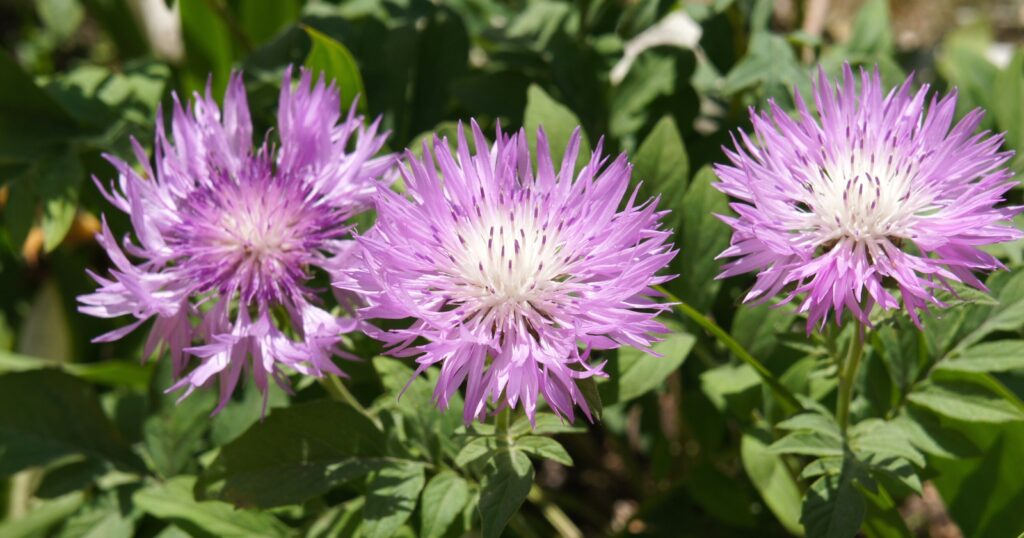
Scientific Name: Centaurea dealbata
- Plant Type: Perennial
- Sun Exposure: Full sun
- Height When Mature: Up to 3 feet
- Soil pH: Acid, Alkaline, Neutral
- Plant Zone: 3 – 9
The Persian Cornflower is a mid-season bloomer that produces pinky-lilac flowers with a light center. The petals are long and thin, adding a fluffy texture to your landscape. The foliage is gray-green and lobed, adding extra texture.
The Persian Cornflower needs a lot of sun to thrive, but it can tolerate (and prefers) nutrient-poor, well-drained soils. Making it an excellent choice for gardeners who struggle to produce prolific blooms. It is native to Turkey and the surrounding areas.
Peruvian Lily
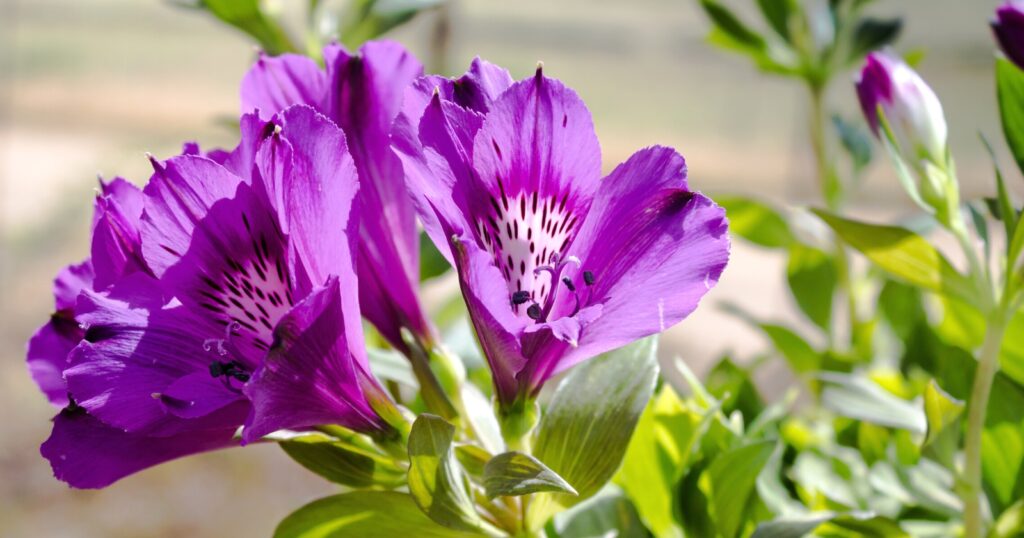
Scientific Name: Alstroemeria
- Plant Type: Perennial
- Sun Exposure: Full sun, partial sun
- Height When Mature: Up to 4 feet
- Soil pH: Acid, Alkaline, Neutral
- Plant Zone: 5 – 10
Alstroemeria is a densely branched perennial with dark-green foliage that can grow up to 4 feet tall. From early summer to fall, it is covered in blooms that come in a wide range of colors. Cleo is an Alstroemeria variety that produces vibrant purple flowers with mahogany streaks and yellow throats.
The Peruvian Lily is versatile, looks excellent almost anywhere in a garden, and pairs easily with annuals and other perennials. It needs fertile and moist soil that is well-drained and in a spot with access to full to partial sun. Overall it is an easy-going plant that is reliable and showy.
Princess Flower
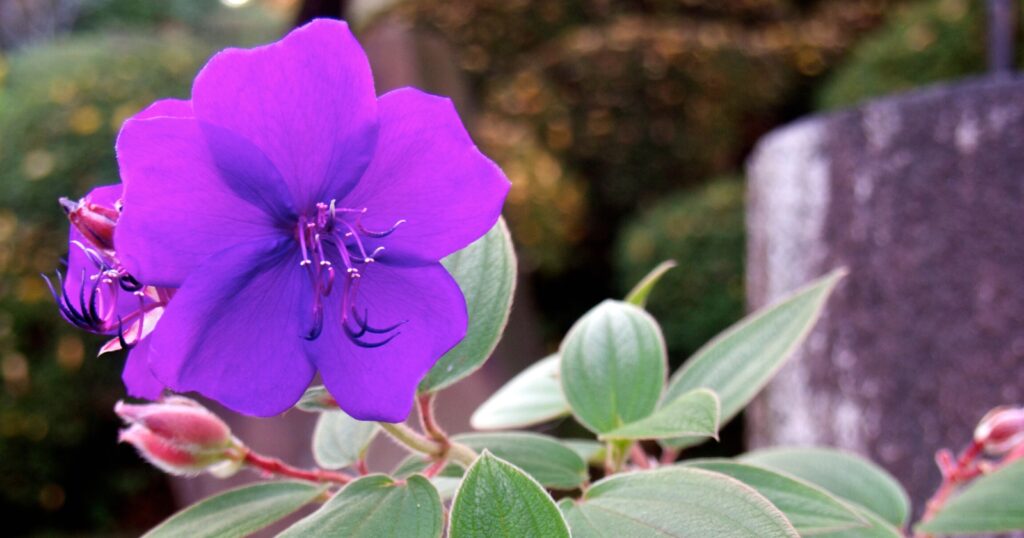
Scientific Name: Tibouchina urvilleana
- Plant Type: Perennial
- Sun Exposure: Full sun
- Height When Mature: Up to 20 feet tall
- Soil pH: Acid, Alkaline, Neutral
- Plant Zone: 9 – 11
Commonly known as the Purple Glory Tree, this evergreen, large tropical shrub produces an abundance of bright purple blooms measuring 4 inches across. So, if you want a vertical purple carpet, look no further. The foliage is hairy and veined with deep red lines and wiry yellow stamens. Together providing texture and additional color.
Princess Flower needs at least 5 hours of sun a day to thrive. In warm climates, it blooms throughout the year. It must be brought indoors before the first frost in colder climates. Princess flower grows up to 20 feet, so it needs to be placed against a wall or trellis for support. It looks great in a container as an accent plant too.
Purple Coneflower
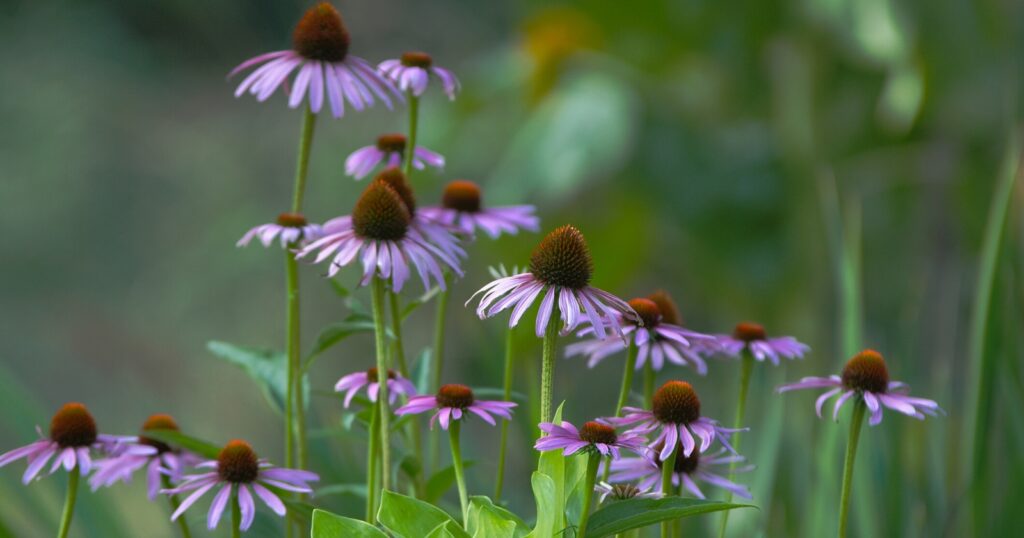
Scientific Name: Echinacea purpurea
- Plant Type: Perennial
- Sun Exposure: Full sun
- Height When Mature: Up to 5 feet
- Soil pH: Acid, Alkaline, Neutral
- Plant Zone: 3 – 8
This Coneflower produces large, daisy-like flowers throughout the summer. These showstoppers look great in any garden, measuring 5 inches wide with a domed center and drooping petals. They are an essential source of nectar for hummingbirds and butterflies and look great when planted en masse.
Native to the eastern US, they have low water needs and are easy-going. They return year after year, and the domed centers provide seasonal interest and food for birds in the winter. It self-seeds freely and can spread aggressively, so it is wise to plant it where it can be contained.
Purple Loosestrife
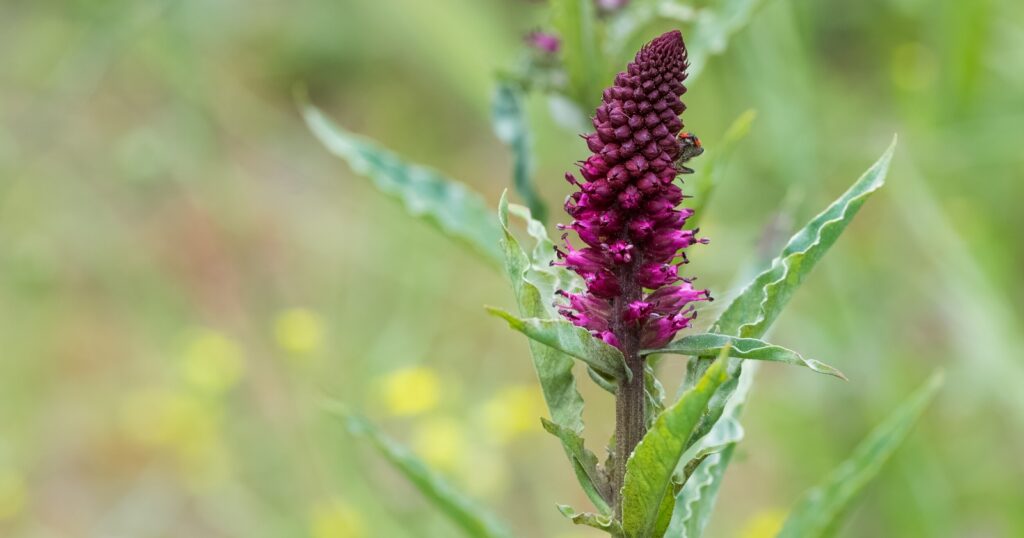
Scientific Name: Lysimachia atropurpurea
- Plant Type: Perennial
- Sun Exposure: Full sun, partial sun
- Height When Mature: Up to 2 feet
- Soil pH: Acid, Alkaline, Neutral
- Plant Zone: 5 – 8
Purple Loosestrife grows in an upright habit with long and slender stems. From late spring until early fall, densely packed flower spikes are born. The flowers are deep red-purple with a lighter tip and open from the base gradually. The foliage is also pretty, thanks to its waxy rosettes of silver-green color, making the purple pop even more.
Purple Loosestrife does best in full to partial sun in evenly moist, humus-rich soil. It must not dry out in the summer if you want to enjoy the long-blooming flowers. It is a low-maintenance plant, but you must watch out for snails and slugs. The large flower spikes make excellent cut flowers.
Purple Poppy Mallow
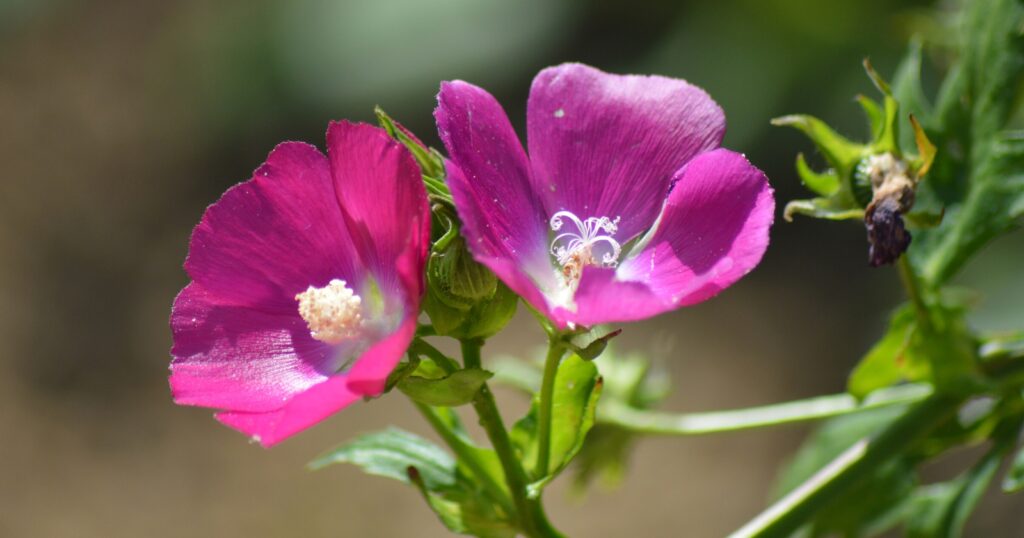
Scientific Name: Callirhoe involucrata
- Plant Type: Perennial
- Sun Exposure: Full sun
- Height When Mature: Up to 1 foot
- Soil pH: Acid, Alkaline, Neutral
- Plant Zone: 4 – 8
Blooming for several weeks from late spring, this low-growing perennial produces masses of purple wine cups. The wide blooms open in the morning and close in the evening. The throat of the flower is white with protruding yellow stamens. This is an evergreen option in mild climates, and the foliage is uniquely beautiful.
Purple Poppy Mallow is a native prairie plant that is easy to establish and hardy against most pests and diseases. It can tolerate a wide range of soils, but good drainage is essential. This purple perennial is a perfect option for the front of borders or rock gardens. It also has a lovely trailing habit, making it a great choice over stone walls.
Purple Prairie Clover
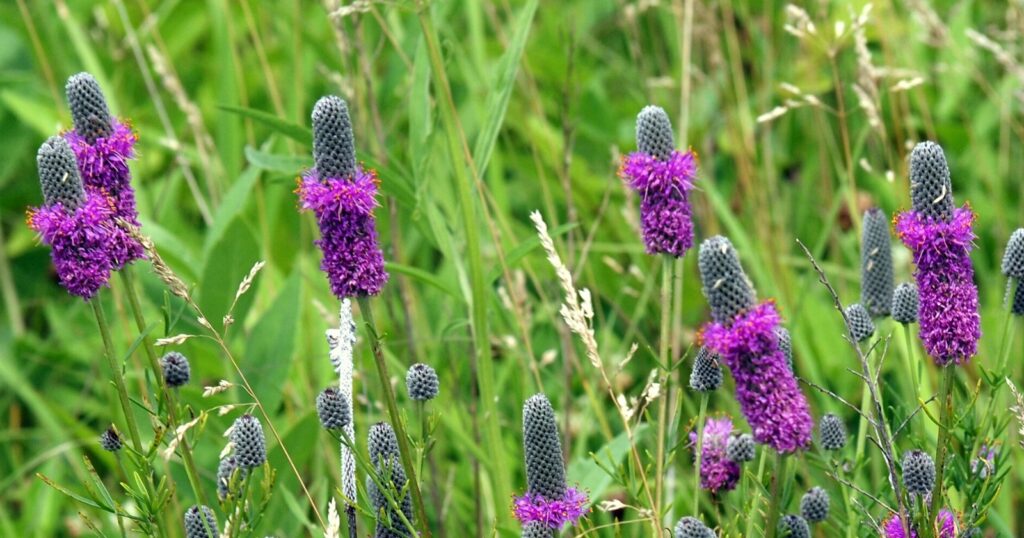
Scientific Name: Dalea purpurea
- Plant Type: Perennial
- Sun Exposure: Full sun
- Height When Mature: Up to 3 feet
- Soil pH: Acid, Alkaline, Neutral
- Plant Zone: 3 – 8
Also known as the Thimbleweed, this is a long-lived prairie native that produces striking purple flower heads. It blooms for several weeks in the summer and is very showy. Bumblebees, butterflies, and other pollinators love this bold choice. Once the purple flowers die down, birds feast on the flower heads too.
Purple Prairie Clover needs dry to moist, well-drained soils. Once established, it is drought tolerant and self-seeds when happy. This perennial is used for prairie restoration projects, and the foliage is a great food source for livestock and wildlife.
Pyrenean Violet
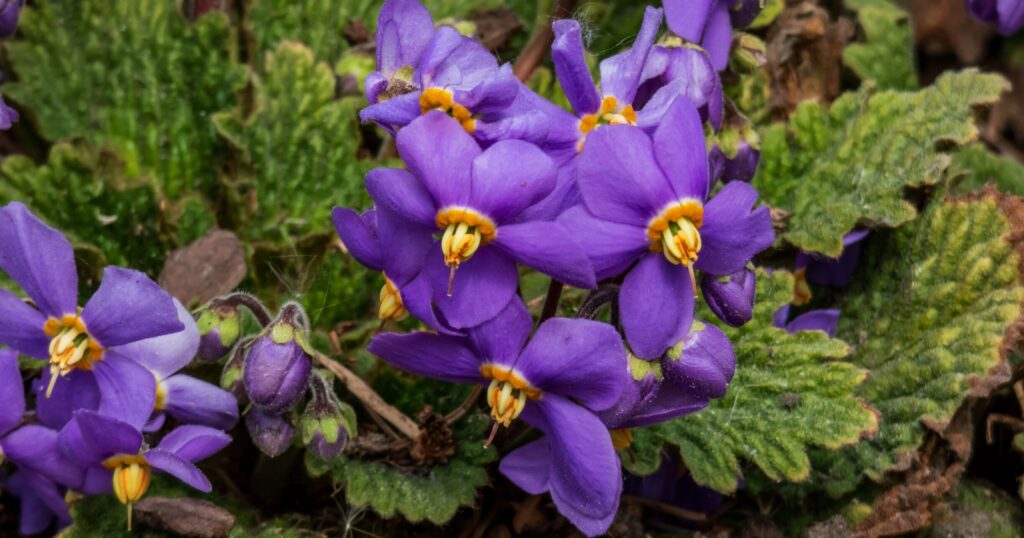
Scientific Name: Ramonda myconi
- Plant Type: Perennial
- Sun Exposure: Partial sun
- Height When Mature: Up to 4 inches
- Soil pH: Acid, Alkaline, Neutral
- Plant Zone: 5 – 7
The Pyrenean Violet is one of the most popular perennials for rock gardens and is native to the Spanish Pyrenees. It is an evergreen low-grower with rosettes of broad and hairy dark foliage. Leafless red stems rise mid-spring and produce small clusters of violet flowers with bright yellow throats.
Like its natural habitat, it prefers partial shade and fertile, moist, well-drained soil to thrive. It is a low-maintenance plant that only has trouble with snails and slugs. It looks great planted in containers too.
Russian Sage
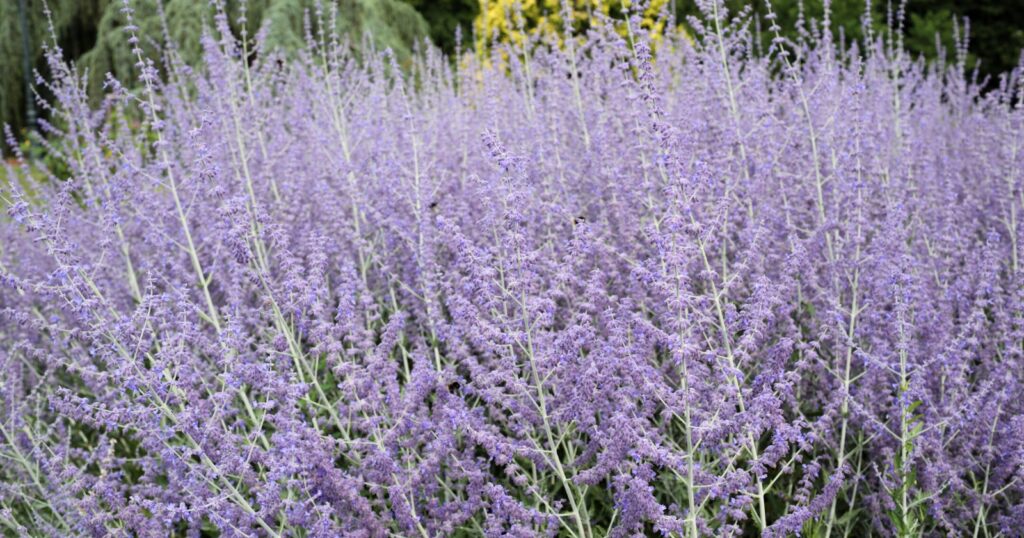
Scientific Name: Perovskia atriplicifolia
- Plant Type: Perennial
- Sun Exposure: Full sun
- Height When Mature: Up to 4 feet
- Soil pH: Acid, Alkaline, Neutral
- Plant Zone: 4 – 9
This is a woody-based shrub with stiff stems that carry rich lilac blooms in whorls, often compared to lavender. The gray-green foliage is also aromatic, and it is an important plant for pollinators. It is a member of the mint family and is native to Central Asia.
Russian Sage can grow up to 4 feet tall and does best in the back of beds or as a hedging plant. It likes full sun, and it begins to flop in partial shade. It needs excellent drainage and good air circulation to survive. Once established, it is virtually pest and disease free, resistant to deer and rabbit, and drought and salt tolerant.
Showy Beardtongue
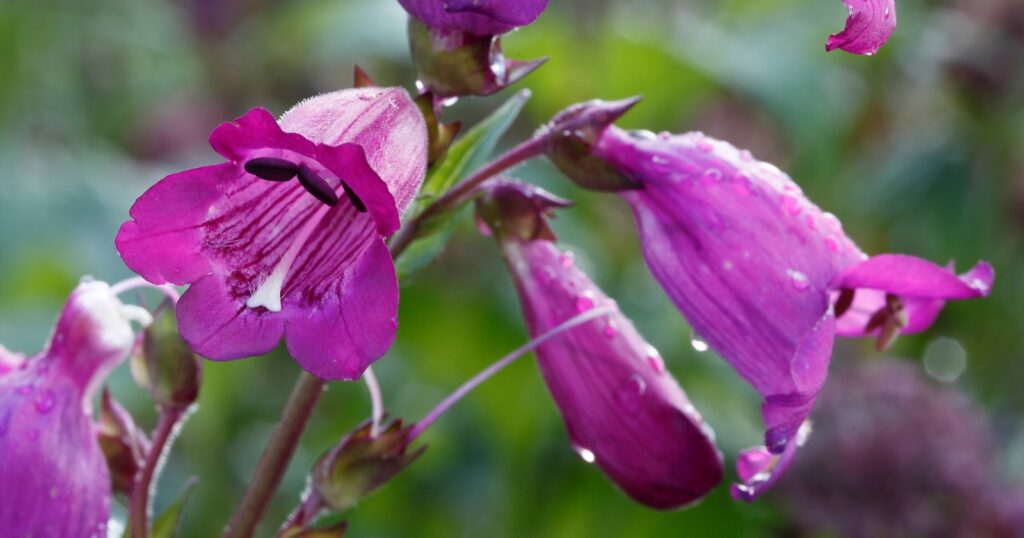
Scientific Name: Penstemon spectabilis
- Plant Type: Perennial
- Sun Exposure: Full sun
- Height When Mature: Up to 4 feet
- Soil pH: Acid, Alkaline, Neutral
- Plant Zone: 8 – 11
The Showy Beardtongue is an evergreen perennial that produces wide-mouthed tubular flowers. It sports a mixture of purple, pink, and azure colors in the same bloom providing a bold color splash from mid-spring for several weeks. The leafy stems can carry up to 100 flowers simultaneously, attracting nectar-seeking wildlife.
Native to California, this perennial likes the full sun, has low water needs, and can tolerate dry soils. It is a popular choice with gardeners because it is simple to grow, easy to care for, and offers a stunning display year after year.
Siberian Iris
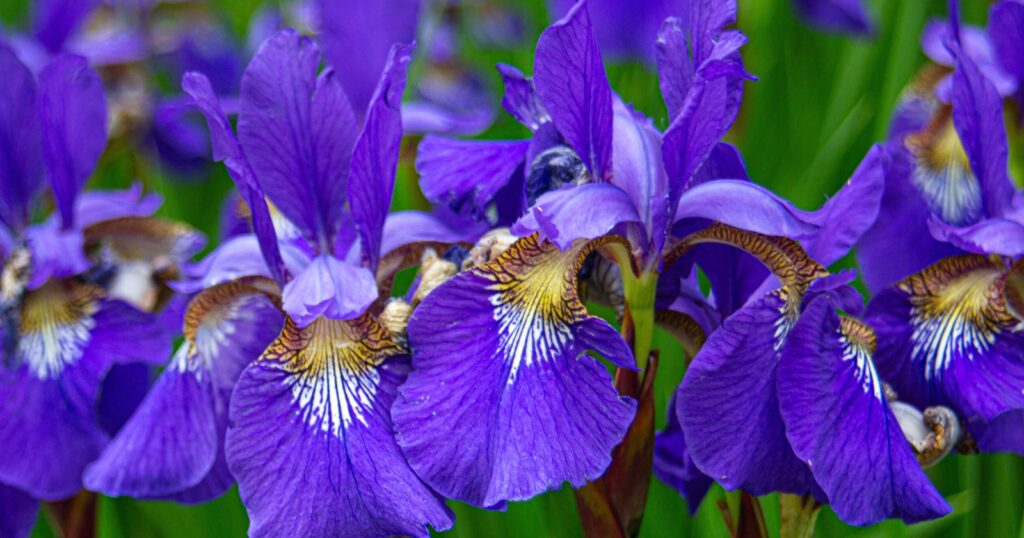
Scientific Name: Iris Siberica
- Plant Type: Perennial
- Sun Exposure: Full sun, partial sun
- Height When Mature: Up to 4 feet
- Soil pH: Acid, Neutral
- Plant Zone: 3 – 9
The Siberian Iris is a charming perennial that produces swathes of bold purple from late spring for several weeks. The blooms appear upon sturdy sword-like stalks, which remain long after the bloom disappears. Siberian Irises are great for adding dramatic vertical lines to any landscape.
Irises like medium to wet soils and slightly acidic soils, and this is where they thrive. Plant them near ponds or towards the rear of your beds. There are many varieties of Siberian Iris to choose from, most sporting pretty purple shades. Award-winning choices include Blueberry Fair, Charming Billy, and Granny Jean.
Spike Speedwell
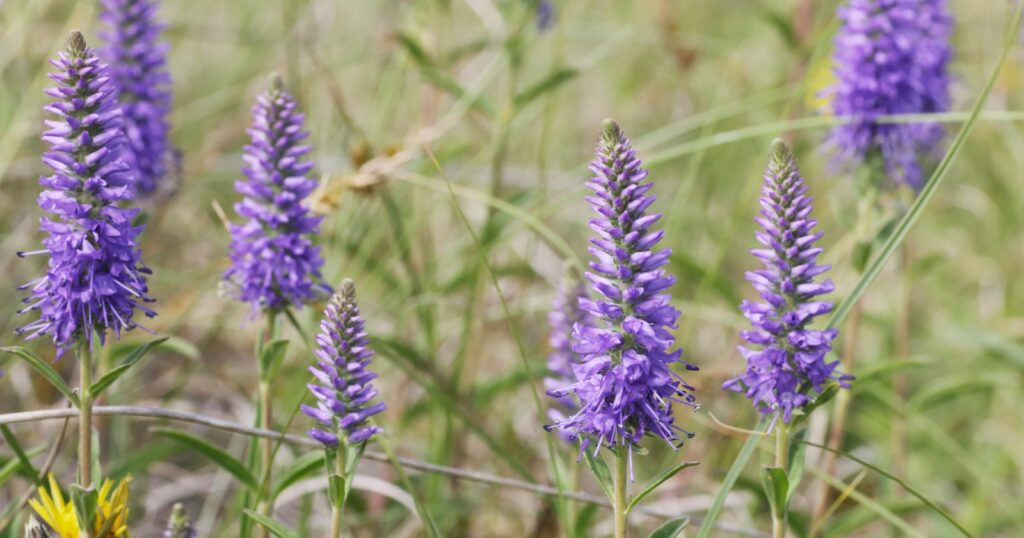
Scientific Name: Veronica
- Plant Type: Perennial
- Sun Exposure: Full sun, partial sun
- Height When Mature: Up to 3 feet
- Soil pH: Acid, Alkaline, Neutral
- Plant Zone: 4 – 9
Spike Speedwell is a reliable and hardy plant and recipient of the Perennial Plant of the Year award in 1993. Thick spikes of rich-purple tiny star-shaped flowers rise from the luscious green crinkly-leaved clump. Densley packed from midsummer until fall, Spike Speedwell is a top performer in beds and containers.
Spike Speedwell likes full sun with a bit of shady rest in the afternoon in warm climates. It likes continuous moisture, but the soil must be well-drained. Butterflies love Veronica, but it also attracts aphids and whiteflies and is susceptible to powdery mildew.
Vervain
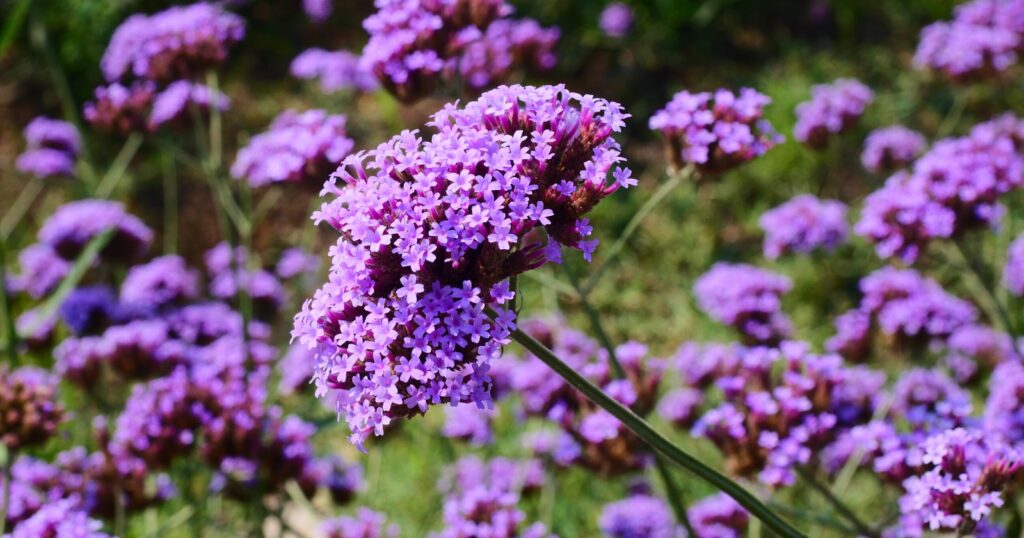
Scientific Name: Verbena bonariensis
- Plant Type: Tender perennial
- Sun Exposure: Full sun
- Height When Mature: Up to 6 feet
- Soil pH: Acid, Alkaline, Neutral
- Plant Zone: 7 – 11
Vervain is a tender perennial that is hardy in zones 7 to 11. Elsewhere it can be grown as an annual. It is a tall plant that provides architectural height, but because of its see-through habit, it can be planted anywhere in the border. It blooms from early summer until the first frost, providing your garden with floating purple clusters.
Vervain is native to South America and is a fast grower, and naturalizes easily. It is an important source of nectar for butterflies and hummingbirds too. Vervain likes full sun and averagely moist, well-drained soils.
Windflower
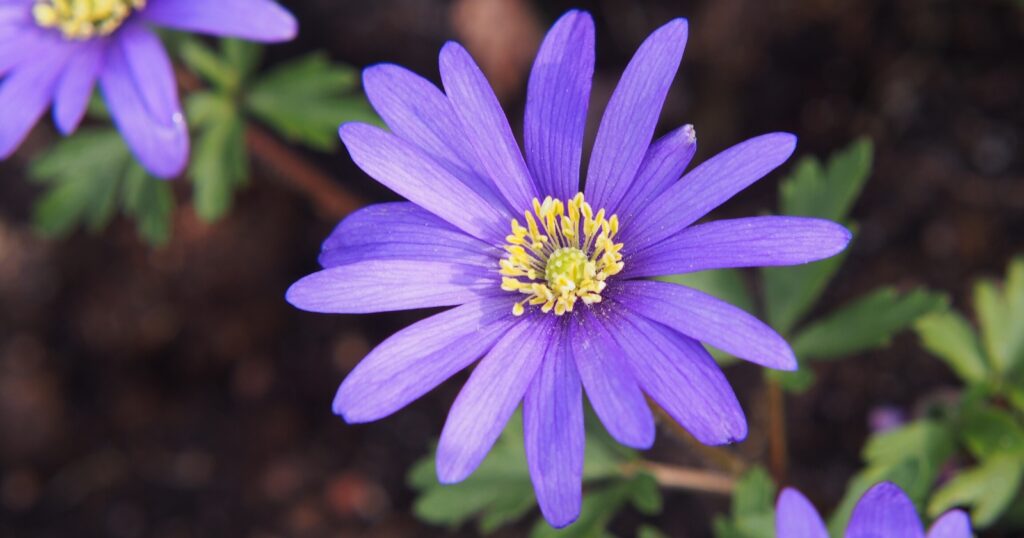
Scientific Name: Anemone blanda
- Plant Type: Perennial
- Sun Exposure: Full sun, partial sun
- Height When Mature: Up to 9 inches
- Soil pH: Acid, Alkaline, Neutral
- Plant Zone: 4 – 8
Last but not least, we have the Grecian Windflower, a popular low-growing bulbous perennial blooming for several weeks in mid-spring. The daisy-like flowers grow up to 2 inches wide, with a yellow center, and produce a neverending rich violet carpet for your landscape. Varieties such as Blue Shades and Blue Star offer some of the boldest purple hues.
Windflowers are low-growing and like partial sun, making them an ideal option to plant under shrubs or trees. They can also grow in the full sun just as long as the soil is continuously moist. Windflowers look great in rock gardens and along pathways and are low maintenance too.
Wrap Up
After reading this list of bold purple perennial flowers, we hope you have found the perfect purple partners for your landscape. Whether it’s the traditional Daylily or the unique Passion Flower, there is something here for every gardener and garden. Just be sure to match the flower’s needs to what you can offer, and you’re onto a purple winner.

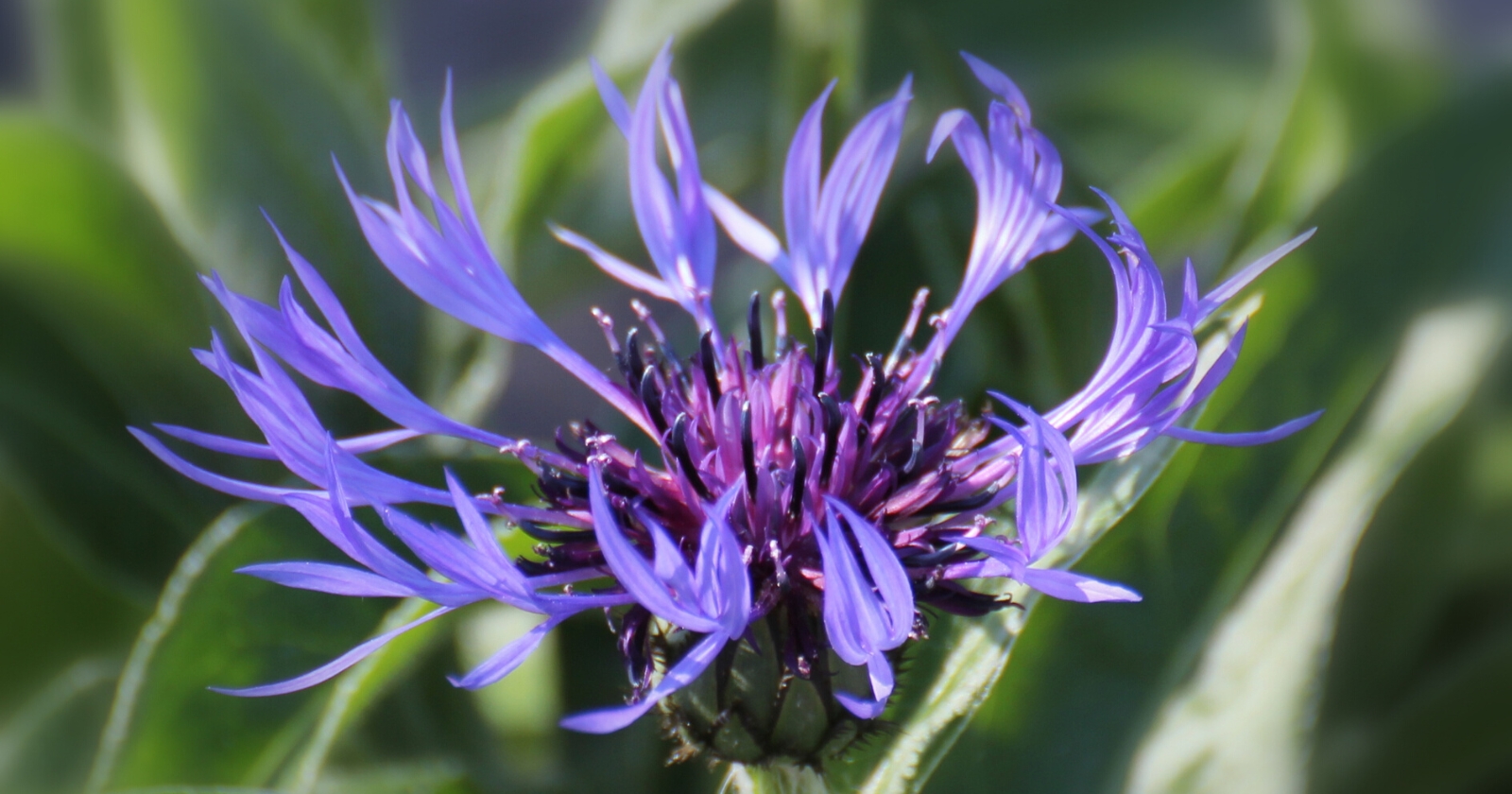
Leave a comment